#its a future cult classic
Explore tagged Tumblr posts
Text


"Through pain, death, war, fear, and inhuman cruelty, Ukraine will persevere as it always does..." Dedicated to all those who have defended and are defending Ukraine. To all those who made this day possible. Eternal memory to all those who were taken by this war. —GSC Game World Team
The release of the sequel to the 2007 cult classic S.T.A.L.K.E.R is now live. The devs, GSC Game World Team, released a brief heartfelt statement in recognition of what it took to make this game under wartime conditions. Several members of the dev team are currently in the Armed Forces of Ukraine, and two have unfortunately died in battle.
One dev, Volodymyr Yezhov, was killed fighting russian forces near Bakhmut. He left behind a brother, Viacheslav Yezhov, who remembers him saying, "Ukraine’s fight today is forging a brighter future for our children."
For the entire dev team, this game is their "love letter to Ukraine". Consider getting a copy of S.T.A.L.K.E.R. 2: The Heart of Chornobyl to support the devs and to support Ukraine.
To read more about the struggles the dev team faced in the making of S.T.A.L.K.E.R. 2, United 24 has an article that details the challenges they faced.
#Ukraine#s.t.a.l.k.e.r.#s.t.a.l.k.e.r. 2#heart of chornobyl#stalker#stalker 2#game#video game#GSC Game World
225 notes
·
View notes
Text
Happy International Lesbian Day! Here's some super brief book recs to celebrate
Books dealing with love, loss, longing and abandonment
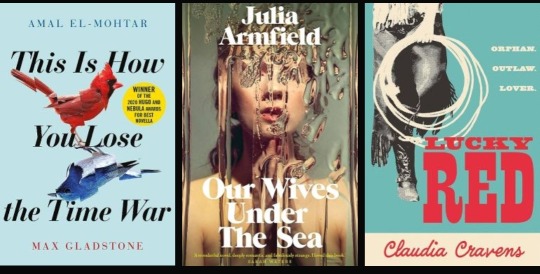
This is How You Lose The Time War is a short but beautifully written epistolary novel between two agents on opposite sides of a time war as they slowly fall in love.
Our Wives Under the Sea is one of the most beautifully written debuts I've ever read about a woman whose wife comes home wrong after they thought she'd died at sea and how it feels to grieve the loss of someone who's still in your home.
Lucky Red is a western novel about a young girl working in a brothel who meets her first female gunslinger and falls head over heels for her, and the consequences that come with loving dangerous people.
Body horror galore

Camp Damascus is about a young woman living in a super conservative christian town built around the worlds most successful conversion camp and the horrors that are uncovered there when praying the gay away fails.
To Be Devoured is about a woman whose fascination with the local vultures turns into obsession and the urge to know what carrion tastes like overtakes her life and leads her down stranger and stranger paths.
Chlorine is about a girl whose entire life revolves around being a competitive swimmer, and how abuse, neglect, and obsession with being the best takes its toll on the young women caught up in these destructive cycles.
Flawed character studies
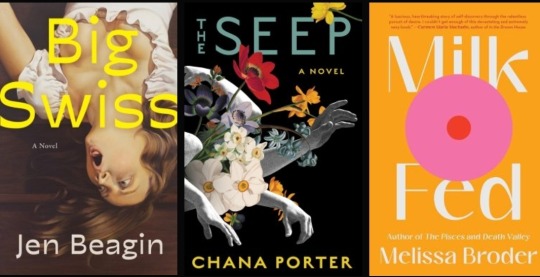
Big Swiss is about a woman who has a kitchen floor reset in her 40s, moves away and starts a new life as a transcriber for a sex therapist and becomes obsessed with one of his clients before inserting herself into this poor woman's life.
The Seep is a speculative sci-fi set in a future where there's been a quiet alien invasion that has given people the ability to make almost any changes to their own bodies and what that world feels like to someone who doesn't want to partake.
Milk Fed is about a woman in therapy who feels cut off from almost everything until she meets another woman who triggers in her a melding of sex, hunger, and religion and where that takes her. Huge trigger warnings for ED content. It gets tough, y'all.
Fantastical wlw books
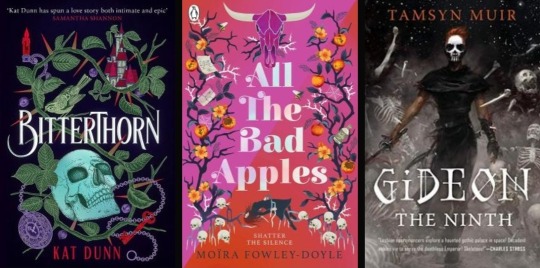
Bitterthorn is an amalgamation of fairytales retold as a slow burn sapphic love story between a sad young girl from a cursed land and the evil witch who takes her as a companion in the latest of the generational sacrifices made to appease her.
All the Bad Apples may be set in contemporary Ireland but it is a fairytale following a young girl as she travels across the country looking for a sister she refuses to believe is dead and the people she meets along the way.
Gideon the Ninth needs no introduction on this site but for the sake of formatting - lesbian necromancers in space who find themselves in an isolated murder mystery plot. It's not a romance but it is a love story and this series will change your life if you let it.
Translated novels
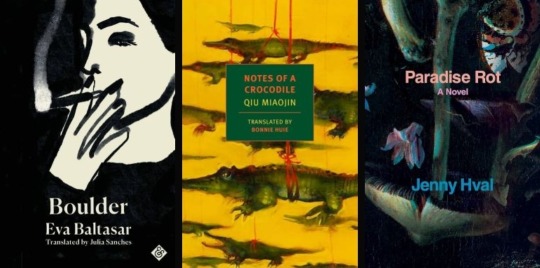
Boulder is a short character study following a free spirited woman when she accidentally settles down with the woman she loves and how love and resentment can take up the same space in your chest when life doesn't turn out the way you hoped it would.
Notes of a Crocodile is a cult classic coming of age story about queer teens in Taipei in the 1980s. It was written in the 90s so please keep that in mind if you choose to read it.
Paradise Rot is about an international student studying in Australia and her growing obsession with her housemate as they share a space that allows no privacy. I've never read anything that feels stickier.
#international lesbian day#book recs#long post#maybe a too long post#but i had the recs so here we are lol#this is how you lose the time war#our wives under the sea#lucky red#camp damascus#to be devoured#chlorine#big swiss#the seep#milk fed#bitterthorn#all the bad apples#gideon the ninth#boulder by eve baltasar#notes of a crocodile#paradise rot#i ran out of tags 😭😭😭#booklr
1K notes
·
View notes
Text
†⠀⠀ㅤֺ⠀ INTRO 2 DESIRED REALITY : FAME DESIRED REALITY .



﹒MARIJOSIE YURI LANE — a burst of color on the hollywood scene, she is everything you’d expect in a modern-day serpentine and more, a mesmerizing blend of mystery, allure, and unapologetic individuality.
﹒physical characteristics — with the delicate sharpness of a sculptured dream, her face mirrors the haunting delicates of twilight, as if painted by the softest brushstrokes of shadow and light.

── AND ACTION!
﹒marijosie got her start on the broadway film of annie (released in 2004), the groundbreaking production that reimagined the classic story with a urban twist. as part of this trailblazing moment in cinema, marijosie brought a luminous depth to her role, standing out with a presence that was equal parts raw and magnetic.
﹒in 2012, we had the chance to catch her again, starring as herself in a comedy skit on the cult-favorite show loiter squad. known for its offbeat humor and unpredictable antics, the series provided a glimpse into marijosie’s playful side, showcasing an ability to cloud her bucket of humor behind an ethereal mystique with sharp comedic timing.
﹒by 2019, marijosie had fully cemented herself as not just a performer but as a visionary artist, stepping into both starring and directing roles with the release of K-12. the fantastical, dreamlike musical film showcased her ability to weave surreal visuals with poignant storytelling, tackling themes of self-expression, individuality, and societal critique.
﹒at the age of 29, she appeared on the stage, firmly establishing herself as one of hollywood’s most compelling talents with her portrayal of claudia in interview with the vampire. she brought a rare intensity to the role, effortlessly balancing the character’s youthful appearance with her centuries old wisdom and turmoil. with this role, marijosie once again demonstrated her versatility, proving she can command both the screen and the audience with every nuanced gesture.
﹒in 2024, marijosie took on the iconic role of elphaba in the highly anticipated wicked film adaptation. with her undeniable presence and captivating vocal ability, she brought a new dimension to the beloved character, imbuing elphaba with a mix of fierce independence and vulnerability that deeply resonated with the audience.

── DISCOGRAPHY.
﹒ marijosie’s musical journey began in 2011 when she joined the provocative and genre-defying collective odd future. her entry into the group marked the beginning of a career that would never conform to traditional expectations. that same year, she released Z, a debut album that immediately turned heads with its blend of ethereal vocals, experimental beats, and raw, emotionally charged lyrics. Z was a captivating exploration of self-discovery and introspection, setting the tone for marijosie’s distinct sound—a blend of haunting melodies, intricate production, and deep, often surreal storytelling.
﹒ in 2012, she released speak for yourself, an album that propelled her further into the spotlight. with this sophomore effort, marijosie began to refine her unique style, weaving themes of defiance, independence, and vulnerability into tracks that resonated deeply with fans. the album’s raw energy and poignant lyrics showcased her growth as both a vocalist and a composer, with standout tracks that blurred the lines between soul, indie, and alternative rock, further establishing her as a trailblazer in the music world.
﹒ after a few years of experimentation and self-reflection, she returned in 2015 with crybaby, an album marked by a darker, more melancholic tone. the project explored themes of heartache, emotional turmoil, and personal transformation, with a gritty edge that was both haunting and cathartic. crybaby cemented her status as a bold, uncompromising artist, pushing boundaries with its raw emotion and unapologetic approach to vulnerability. the album was praised for its lyrical depth and sonic complexity, capturing the chaos of personal upheaval while embracing the beauty of the struggle.
﹒ in 2019, marijosie released K-12, a groundbreaking album that tied into her film of the same name. with this album, she fully embraced her vision as both a performer and a director, creating a concept album that was as cinematic as it was sonically diverse. K-12 became more than just an album—it was an artistic statement, blending surreal, dreamlike soundscapes with poignant, socially conscious lyrics.
﹒ in 2021, marijosie released preacher’s daughter, an album that delved deep into the conflict between spirituality and rebellion. Infused with religious imagery and a sense of existential reckoning, preacher’s daughter was a personal exploration of faith, family, and the search for truth. with a more stripped-down sound, the album highlighted her vocal prowess, while the lyrics explored the complex relationship between divine love and personal autonomy, striking a balance between vulnerability and empowerment.
﹒ her latest album, alligator bites never heal, released in 2024, marks another evolution in her musical journey. the production itself mirrors the album’s themes—lush, unpredictable, and occasionally jarring—echoing the internal chaos of a woman trying to navigate her pain while asserting her power. it’s a sonic tapestry that feels as jagged as it does beautiful, reflecting marijosie’s growth as an artist who refuses to fit into any one box. the project is at once a battle cry and a healing mantra, blending dark, moody undertones with glimmers of hope.

── AND, YOUR PEN NAME?
﹒ another aspect of her artistry lies in her writing. an author of three books, her prose mirrors her music—haunting, poetic, and deeply evocative. her debut novel, a haunting tale of a teenager navigating war, burdened by the past, a god that feeds on grief, and a country’s fate tied to the history she’s running from, has cemented her place as a rising star in the literary world. with a TV adaptation (by yours truly) in the works, she’s poised to step into yet another creative realm, embodying the characters and world she’s crafted with perfect authenticity.

#reality shifting#shiftblr#shifting community#shifting motivation#shifting blog#shiftinconsciousness#shifting diary#black shifters#shifting antis dni#desired reality#shifting realities#reality shift#shifting consciousness#shifters#shifting#shifting advice#shifting script#realityshifting#fame dr
70 notes
·
View notes
Text
TMAG Theory Board Update (EP 11-12)
Hi guys sorry about the late posting I've just started a new quarter of college and its been pretty hectic. also got into my school design BFA program so pretty stoked about that! Anyways lets get into the Episode Breakdowns because even though not a lot of lore related things happened I still have a lot to talk about
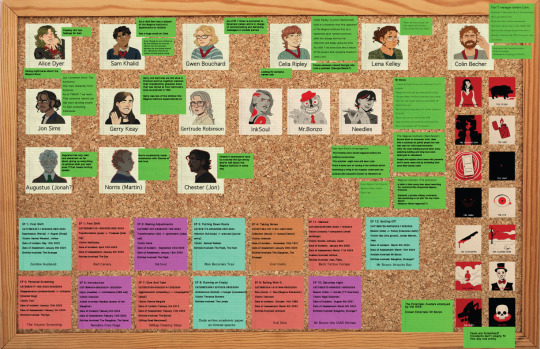
For the breakdown I'll separate each by episode in sequential order
What Happened in Episode 11: Marked
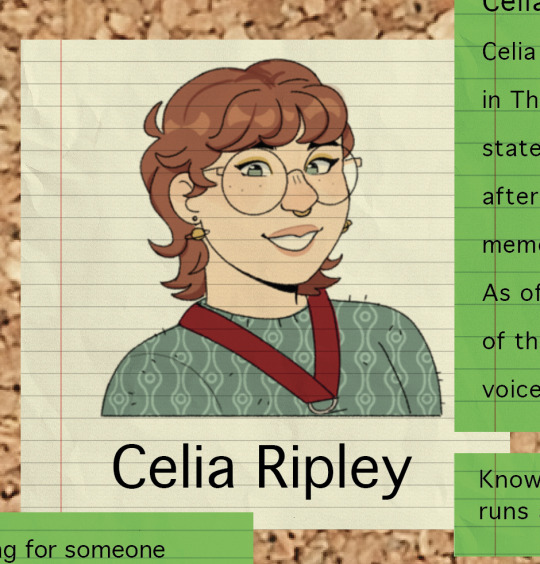
Celias Rude Awakening- we jump right into the weirdness straight away with Celia waking up on the side of the interstate. she indicates that this is not a weird occurrence and ends the scene by telling someone named Jack that she's "on her way." If you remember episode 8 after Celia and Sam talk to Gerry and Gertrude, she mentions stuff about wanting help with her own mystery. When Sam asks about it she says she's looking into Time travel, other dimentions and teleportation. Many people have theorized that maybe Celia is just a super heavy sleepwalker, but I think the she teleports random places out of nowhere. This could be a side effect of her reality hopping if this Celia is originally from The archives universe.
As for the identity of Jack I'm not quite sure about that yet. I cross referenced the name Jack with past episodes of TMA. The only thing that came up was Jack Barnabas from the statement about dating Agnes Montague (aka an avatar of the desolation and Jesus-like figure for the cult of the lightless flame) So Unless Celia is secretly Agnes of Agnes reincarnated , I can't find any way to link Barnabas to Celia. (if anyone has a theory feel free to send it my way.)

Sam Lore- this one is pretty minor story-wise but I thought it was interesting. Before the statement for the episode is presented we get some classic Sam and Alice Banter ™ most of it is pretty lighthearted but I noticed Sam mention something that could indicate he might be an amputee.
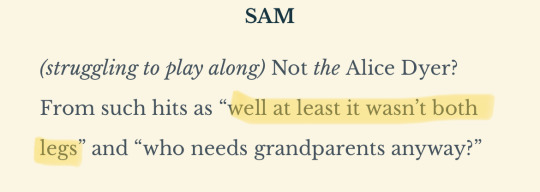

These could not mean anything and I find it weird that it hasn't been mentioned until now but thought it was kind of cool and I will probably be drawing sam with a prothetic leg in the future cause I really like this head-canon. It also begs to question if he is missing a leg. it might have anything to do with his past as a Magnus institute test subject but then again could just be a fun character detail added by Jonny and/or Alex .
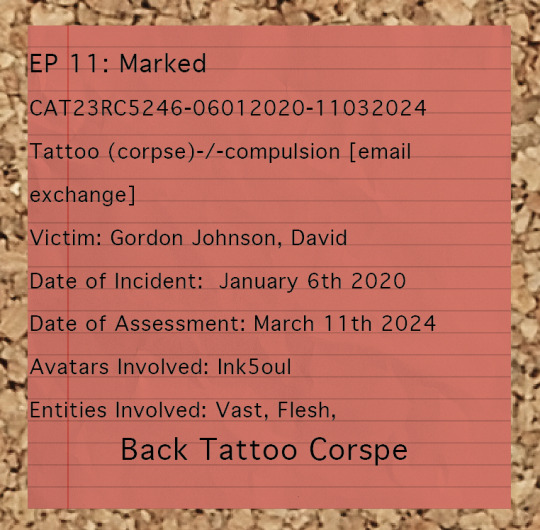

The Statement- Getting into the statement we get another Ink5oul appearance. Also possible Ink5oul identifying as she/they. (and lets be honest being a fear avatar is pretty non binary core). I found this Episode gave me a feeling of a hybrid between the Vast, Buried and the Flesh some people are theorizing that is might be a new entity called the Deep but I think that the fear of the ocean could easily apply to the vast or buried. Not much to say about this story though pretty standard Magnus horror that also gave us a hint to what Ink5oul's goal could be/which entity they serve.

Post Bonzo- Gwen has a debrief with Lena after her first Externals Liason assignment and her meeting with Mr. Bonzo. Undoubtedly Gwen is still pretty shaken from her encounter, even arriving late to work due to sleeplessness. Gwen is able to ask Lena a few questions mainly she wanted to know who's name was written on the letter given to Bonzo
Lena is largely unhelpful but tells Gwen she should have worked it out by now and if not to pay close attention to the case load for the next couple of days. before the latest episode my guess was Klaus because that is the only person mentioned so far that the OIAR intends to kill. but more on that later
Marked- Now were getting to my favorite thing about this episode. This episode title can have two meanings. The first is the more literal interpretation. Tattoos are marking of the body and the case this episode was all about tattoos so easily a good name would be marked. But I believe this is a red herring meant to misguide listeners who have not consumed all 200 episodes of TMA because if you know the world of Magnus Archives the term Marked takes on a entirely different meaning.
In TMA the term marked is used to indicate that somebody has been influenced by one or more or the fears and are one their way to becoming an Avatar. I think this could be a coded way to tell the audience someone in the OIAR has been marked. I have two potential candidates
Alice Dyer- Alice has been having dreams about the Institute after her and Sam's adventure into the ruins. also she mentions feeling like someone's watching her (common to people influenced or fed upon by the Ceaseless Watcher/The Eye) My guess if she is marked it would be by the Eye.
Gwendolyn Bouchard: Probably the most likely culprit. The main way an entitly tends to mark people is through encounters with other avatars. Gwen has just had an encounter with Mr Bonzo last episode who I strongly believe must be an avatar of some sort.
What Happened in Episode 12: Getting Off
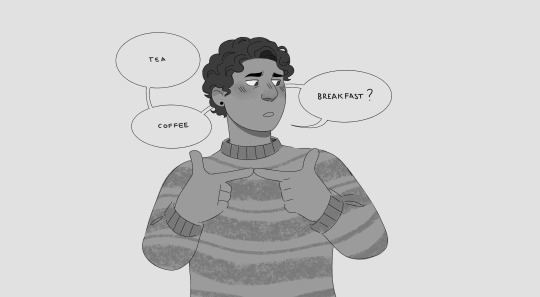
Aww Sam!!- Sam asked Celia out and it was adorably awkward. not much to say I just loved this interaction and I'm longing for a new Magnus brand office romance hopefully is wont be an agonizing slowburn that ends tragically like a certain pair of morons from Archives (I love you Jon and Martin but Jesus christ)
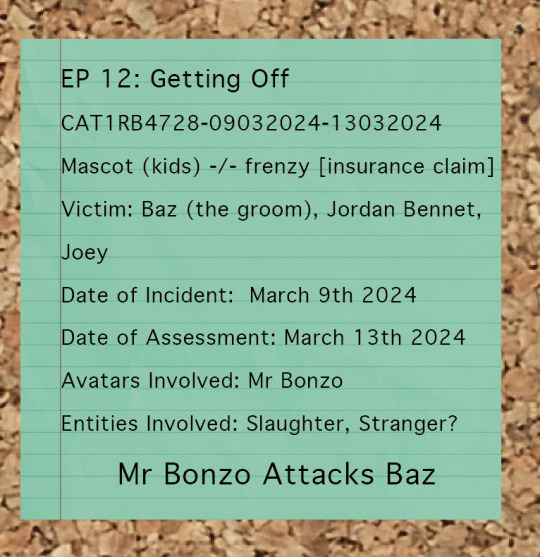

It's Bonzo time bitches!!- Probably one of the most gruesome Magnus statement I've ever listened to (good work Alex) Mr Bonzo completely annihilated some poor dude at his bachelor party. Based on the date of the Incident the I can confidently say that whoever Baz (the groom) was he was our mystery person the OIAR sent Mr Bonzo to get rid of. Along with some of the bloodiest imagery we learned a few things about Bonzo. The most interesting detail is that Bonzo has to be summoned by playing his theme song I think the CD of his theme song acts somewhat like the tapes did in TMA by materialising out of nowhere. Also fun fact you know that torn seam that is right down Bonzo's middle? that is actually is his mouth lined with rows sharp teeth so I guess I know that now (so fun) Moral of the story dont f*ck with Mr. Bonzo

Alice knows something: Theres been this recurring audio glitch throughout TMAGP thatnks to a few extremly observent fans we have started to relize that these glitches are not at all random and are actually letting the audience know when a character is lying (i actually reposted somones deepdive into all the istances of this glitch so far if you guys are intrested in knowing more) why i bring this up now is becuase since we know when any charater is lying we also know when they are being truthful if there is no glitch when they say somthing and at the end of this episode this interaction occurs
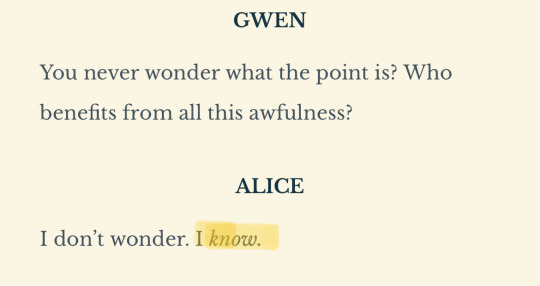
Alice goes ahead and makes a joke about this to annoy Gwen but the fact theres no audio glitch when she says "I know" means she does actually know who is behind the OIAR and is activly refusing to share it with Gwen or the others. What do you know Alice!?
and that's about it im already loving these next batch of episodes and am so excited to learn more (ERROR has to show up somtime )
thanks to everyone who resonded the poll on the last update I will continue to include drawings into the breakdown even if it takes me a little bit of time to post. anyways I wrote this all in one sitting and I'm about ready to pass out so thanks again and the ask box and comments are always open for discussion and theory crafting.
-Echo
#the magnus protocol#augustus tmagp#tmagp#chester tmagp#gwendolyn bouchard#jonathan sims#lena kelley#martin blackwood#norris tmagp#tmagp theory#ink5oul#tmagp fanart#tmagp spoilers#the magnus pod#magpod#tmagp speculation#magnus protocol#magnuspod#alice dyer#gwen bouchard#samama khalid#lena kelly#celia ripley#tmagp celia#rusty quill#alexander j newall#celia x sam#tmagp thoughts
174 notes
·
View notes
Text
Some Highlights from the Scary Godmother Compendium 🎃🧹💀
You mean to tell me you guys have been sitting on this image without context since 2001 and nobody ever put it on Tumblr.com!?

But seriously, this part threw me for a loop! The context is actually really fun.
...
And is this one of the newer stories? It sounds like it is setting up more to come?
Hannah is a little older, and maybe even "tweaking her origin story"???

Also Orson is a DJ!

There was also a huge tone shift with the "Ghouls Out for Summer" storyline that could be another, more mature movie all its own and could set up tons of future stuff!
...
The only thing I think I missed was a story where Scary Godmother almost got married??? Like I may have skipped over it by mistake, but I was like... uhhhh.... when did that happen?
...
Anyway, the book is filled with comics galore from the 90s to now, with tons of characters and moments that never made it into the 2 specials.
Go support Jill Thompson and this Halloween cult classic (hopefully with more to come🤞)!
Link to the book on Amazon, but if you find it elsewhere, as always, support your local book retailers.
#scary godmother#compendium#jill thompson#hannah marie#orson#orson the vampire#Bug-a-boo#skully pettibone#harry the werewolf#count max#queen ruby#How about something more fun to look at today?#roninreviews
30 notes
·
View notes
Note
As a back to the future fan, I love seeing all of your posts, analysis, fic, etc. on the subject. Now that my daughter is old enough to, we’ve started to watch some of my favorite movies from when I was a kid together, starting with Atlantis: The Lost Empire. As someone who enjoys a Michael J. Fox character, what are your thoughts on Milo Thatch?
My daughter asks constant questions during movies, so I enjoyed explaining the part in the beginning why it was so difficult for Milo to present his research to committee in an attempt to secure more funding (now with real life experience).
I love Milo Thatch, and Atlantis: The Lost Empire. Far and away my favorite Disney movie and character, and I will mourn forever that it didn't take off the way they were hoping it would (there was going to be another theatrical-release movie! and a TV show! and they were going to theme part of the parks after it!), though its well-deserved status as a cult classic these days makes me very happy.
I love that Milo is geeky and intelligent, but really comes across as sweet and idealistic, too. These days I can have complicated feelings about liking characters who are shown to be conventionally academic, but my favorite things about Milo are honestly more that he's a genuinely kind, decent guy--and that his passion for academics clearly comes from a place of love for the subjects he studies, not from being particularly high-achieving. He just wants funding, haha. And it doesn't hurt that he's played by one of my favorite actors (especially since I think it's neat that Michael J. Fox was able to swerve into voice acting for a while as his health issues got more serious). Milo's been on my "cosplay someday" list for ages, and I should really get around to putting one together.
Also, I feel you on having a somewhat different perspective on that part in the beginning as you've had some of the same experiences. I think it's fascinating that Atlantis really feels like it was made with the adults in the audience in mind as much as the kids. Definitely one of the reasons it's such a good movie!
22 notes
·
View notes
Note
ok idk if you're sleeping BUT when you're available i would love to hear about ur latest skz concert experience <33
HI ok saur i’ve just washed up so let’s GO!!!!!
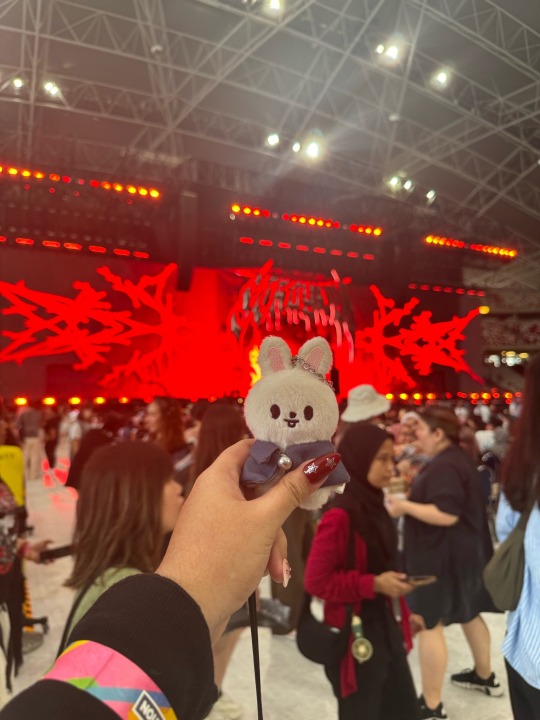
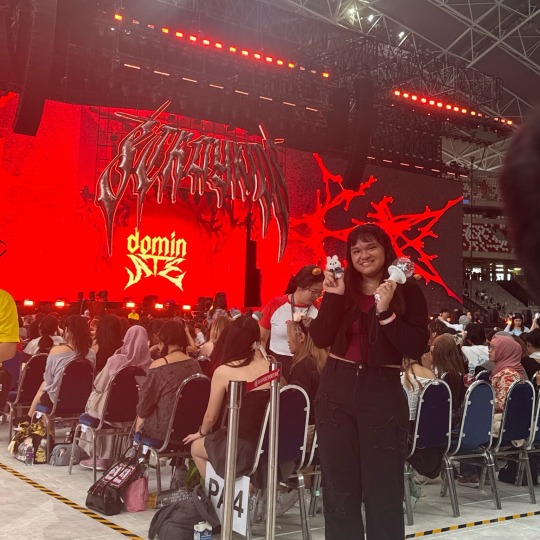
dominATE tour!!! i was so so lucky to get a good seat (cat 1 second row!) but my other concert buddies… were slightly further behind. i went alone but met up with other stays who also went alone, so we became a cute little group of 4! spent the time looking around and taking pictures together 🥺 they’re the cutest bunch ever. tbh it’s not my first time going alone (i.e skz maniac, cha eunwoo just one 10min) so i wasn’t that lost, but some of the other girls were so i became some sort of a mother duck weaving them through the crowds hahah !
i made little bracelets and gave them out as fansupport! was seated next to two j-stays and when i gave them, they went “kawaii!!” repeatedly; they’re so cute uGH
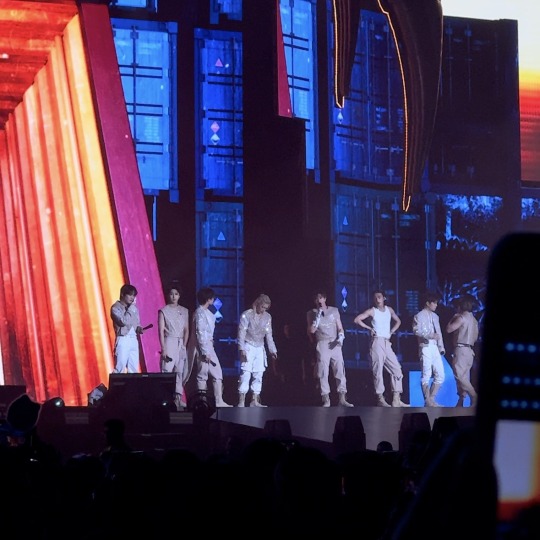
chan said he’s so happy to be able to kick off the start of the world tour in singapore 🫶 (in a later ment, he said he was jealous of stays who live here because it’s so pretty, and would love to spend more time here in the future :() he also made a lot of jokes about how it’s so “cold” here (haha :|) but ultimately said it’s hot because of stay 🥹
changbin did the chilli chilli crab crab dance again!! seungmin said they ate that yesterday, and that probably before their flight tomorrow they’ll eat pepper crab! changbin asked to share and seungmin said no because changbin eats 2 portions each time 😭😭 save my man please 😫
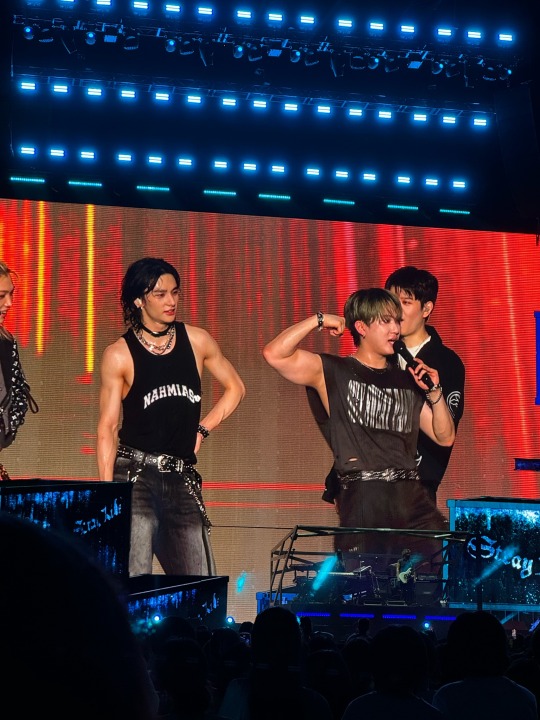
speaking of!!! changbin is my concert bias once again!!! idk man it’s just something about him that draws your eyes towards him… his stage presence is really no joke. he’s also super buff irl (please put me in a chokehold) (lovingly)
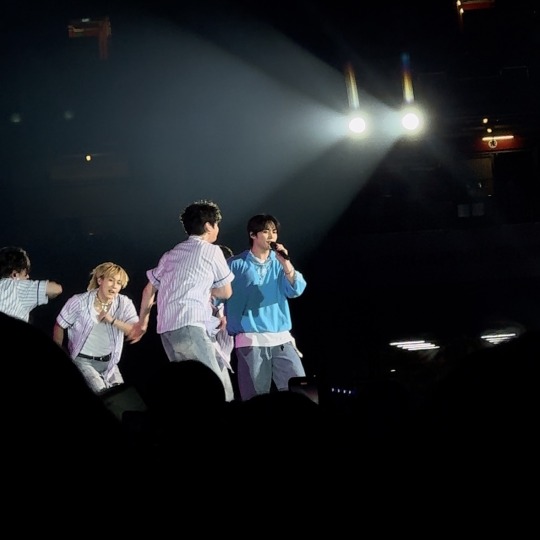
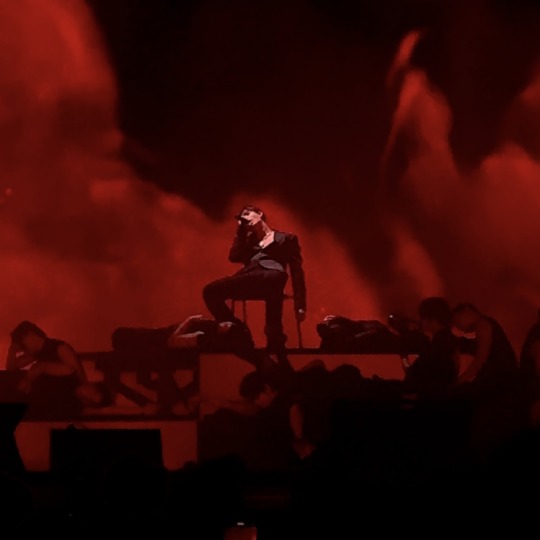
THE SOLOS1!!1!1!1! THEY’RE ALL SO AMAZING!!!!! seungmin was so angelic on the guitar! jisung and minho were so cute and fun to jump to! hyunjin!! such beautiful choreo!!!! the fact that they put chan’s and jeongin’s back to back is so criminal tho like how did they expect me to recover from shirtless chan to body-roll jeongin combo???? felix said his solo was based off beast’s pov from beauty and the beast! 🥺 of how life was so unfair for him 🥺🥺 and then when be the crowd was chanting “baby bread! baby bread!” seungmin then went on to say “nonono, he’s a man now” WHAT IF I CRIED!!!!!
they also played cult classics: miroh, district 9, MY PACE, back door, god’s menu, thunderous, case 143. i will never stop loving you, miroh.
at one point they were all just throwing water at stays and each other. they should’ve gone to waterbomb lmao i would’ve loved to see them with the water canons
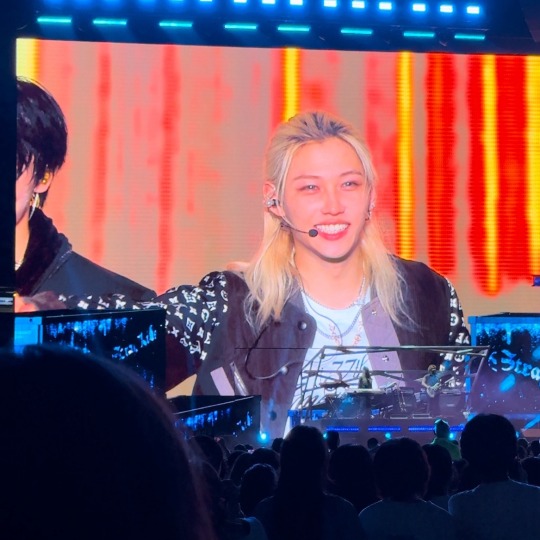
omg as i was collecting confetti after the concert, a security aunty came up to me and was like “hi can i ask who was the one with the long hair?”
and i was like “oh the blond one?”
and she was like “yeah! the one with the half bun!”
so i was like “oh! that’s felix!”
“felix? like f-e-l-i-x?”
“yes, felix!”
“oh, he’s very handsome!”
“right??”
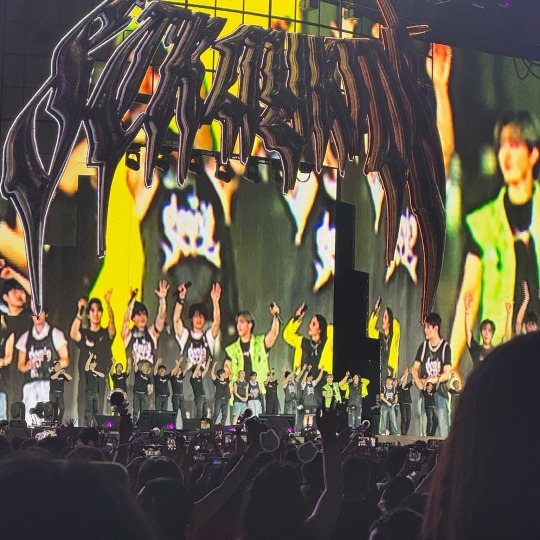
tbh i think last year’s maniac tour was better :/ maybe its because of the intimacy of the indoor stadium as compared to national? i also preferred last year’s setlist too T-T there’s no hellevator, haven, rock or yayaya 😪 they did have social path this year tho! and stray kids! lonely street and i like it too!! it’s the little wins 🥹
anyways 8/10 solid concert i love skz with all my heart and stays are so nice! it’s a blessing to be able to see my ults three times now 🥹 i’m p sure there’s more but i think i forgot haha will leave off with a message from chan:
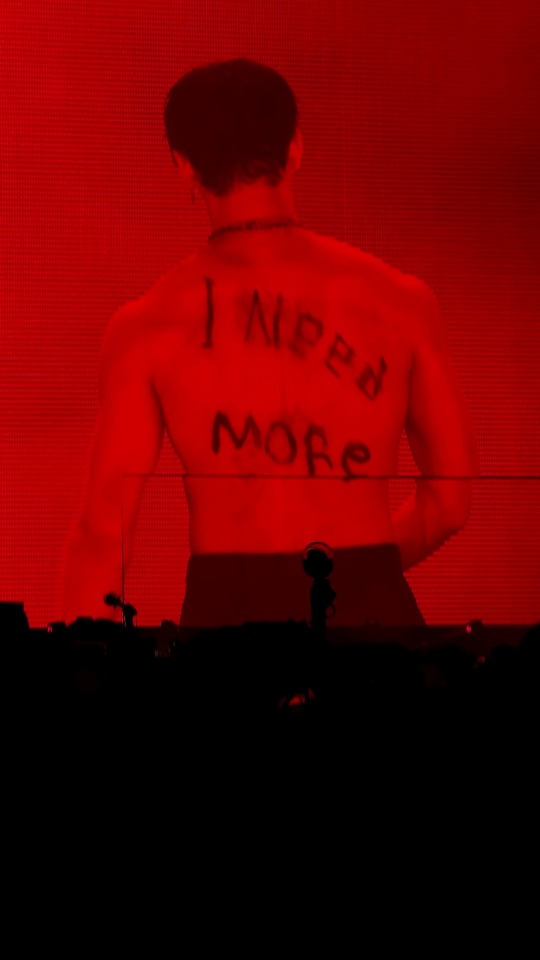
27 notes
·
View notes
Text
In Defense of Future Diary...
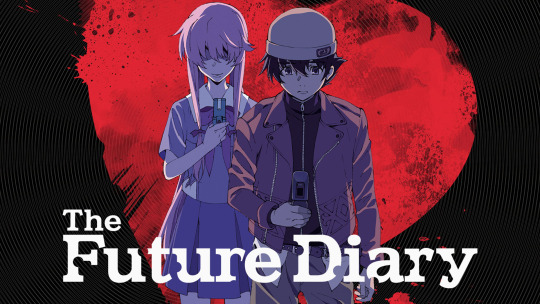
TW: lots of yapping.
Making a small essay for Future Diary is something I’ve been meaning to do for a while. Since my entire blog is dedicated to the series, it only feels right to put something like this out into the ether. However, I’m never sure of the topics that I want to discuss the most. Do I write a defense for the show? My reasons for loving it so much? Its relevance and importance for anime culture? An analysis of Yuno’s character? There’s so much I feel you could say, but I never find the right words to express my feelings coherently. Today, I’ll make the attempt, though. I’ll go over all of the aforementioned questions here, mostly focusing on my personal opinions and feelings regarding the show. I don’t have much experience writing essays or analyses of media, so sorry in advance if my yapping is all over the place.
To begin, I should probably address the elephant in the room: Future Diary, despite its popularity and almost cult-classic status, has turned into a show people love to hate. You see it everywhere, when it comes to reviews, comments, opinion pieces, you name it, if it has Future Diary on the title, people will let you know all the gripes they have with the show. And while I tend to feel defensive or even saddened when I see so much hatred directed at my favorite show… I don’t necessarily blame anyone for feeling that way. I don’t want to be one of those people who pretends to hold the intellectual high-ground, acting as if everyone else is media-illiterate and I’m the one who truly gets the meaning of the series. At the end of the day, it’s just an anime, it’s not that deep. Everyone’s gonna like what they like; we all have different tastes and interests, so it’s only natural we all hold such different opinions about the show, especially given its campy, gory and almost edgy nature. Future Diary is definitely a product of early 2000’s trends, which some people (me lol) appreciate, and others certainly don’t.
That being said, while I respect people disliking the show for personal reasons, there are certain criticisms I see thrown its way that are not necessarily warranted. These issues can be boiled down to the following categories: “plot-holes,” a weak protagonist and toxic pairings. I’ll delve into all of these in a second, but I must say, the amount of times I’ve seen these specific points parroted over and over again makes me believe that many of the people making these arguments are piggybacking off of one another. It’s almost like they’re following a trend, repeating how the protagonist “sucks ass” and that the plot makes zero sense, without showing any examples as to how.
It’s really common to find shallow arguments like those in comments sections and forums, but since I don’t want to feel like I’m barking up a tree in writing this essay, I decided to look for a source that encapsulated all of the common criticisms, while also backing them up with examples. Now, there are many good video essays out there on Future Diary, my personal favorite is by The Hot Box. But as far as critical pieces go, the one I found that goes the most in-depth is by the creator NezumiVA, titled: Mirai Nikki is Garbage, and Here’s Why. I’ll be referencing the video as I go along, but please note that while I disagree with many of this creator’s arguments, I don’t intend this to be a personal attack. As I said earlier, we’re all entitled to our different tastes and opinions, I can respect them disliking the series while having my own criticisms to give regarding the video. Just a little disclaimer so my intentions aren’t misconstrued here.
With that out of the way, let’s take a deeper look into the main three arguments I mentioned before:
“The plot-holes eat up the show”
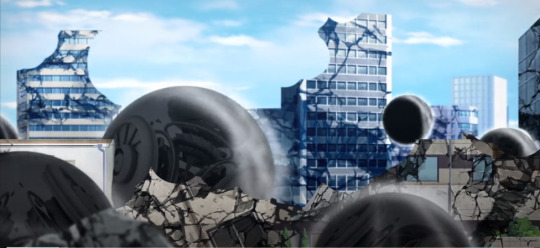
If you’ve been in the fandom for a while, you know that this is probably one of the most common criticisms levied towards Future Diary, and perhaps the one that holds the most weight. Or at least it would be, if it weren’t for the fact that “plot-holes” aren’t exactly the issue people are pointing at here. To explain, I believe people who dish out this claim all have different understandings of the definition of “plot-hole,” so to clarify: a plot-hole is an inconsistency, a contradiction in the narrative. For example, Yuno’s diary is all about Yukki, if she were to have diary entries not about him, that could be considered a plot-hole, as it contradicts the original narrative. A smaller detail being unexplained or overlooked for the sake of pacing is not a plot-hole. A flaw, yes, but as long as it doesn’t contradict what’s already been established in the story, it’s not a plot-hole.
On one hand, it is true that there are certain Deus Ex Machina moments that aren’t properly explained in the show (heck, the god of this universe is called that for a reason), such as: how does 5th acquire all of his booby traps? Or where did 9th pull that motorcycle from? Why are characters so quick to forgive/forget certain events? These are smaller details that aren’t properly justified on-screen for the sake of pacing and making the show more interesting. You could possibly count this more as a case of poor characterization, particularly with 5th’s character having a lot of knowledge despite his age or Hinata quickly accepting the coin toss challenge despite having an advantage. Given the show only has 26 episodes, it’s only natural that detailed explanations for smaller details are omitted to make the show flow quicker and be more entertaining. While this may bother some people, I don’t find it to be such a big deal, or at least not a reason to dogpile on the show, when many other animes with shorter runtime fall victim to poor characterization as well.
Many deem the plot nonsensical for missing these smaller explanations, but again, I find that exaggerated as they’re much, much trivial details that the majority of people don’t think of or focus on when watching the show. The video I referenced touches on the plot being illogical several times, not necessarily mentioning plot-holes per se, but complaining that many of the justifications behind certain plot points are unrealistic or contrived, though let’s be real here… since when is anime realistic? Future Diary, I would argue, does a good job of balancing very unrealistic scenarios with some realistic characters (like Yukki, but we’ll get into that later), which is what makes it interesting to watch. After all, what’s the fun in watching a fantasy show if it’s completely grounded in reality? Not to mention that many of the points brought up in the video aren’t contrived, especially if you were paying attention to the show. For example, the scene of Yuno meditating to figure out Reisuke’s plan. This wasn’t a Deus Ex Machina moment, it was foreshadowing of the fact she has her first-world memories locked away, and the meditation was her trying to access those memories. Same thing with Bacchus having an overpowered diary, it isn’t for the sake of it, he literally designed it to be that way, because he was the one who presented the idea of the diaries to Deus in the first place.
I’m getting a little side-tracked here, but you get the point. Ultimately, the worst sin a show can commit is being boring, and while Future Diary has its flaws in pacing and characterization, it contributes in keeping the viewers hooked to the action, packing its small run of 26 episodes with quite a bit of entertainment. Moreover, a lot of people overreact to these so-called “plot-holes”, yet they also fail to pay attention as to why things happen as they do in the show. Many of these criticisms can be summed up as either: trivial details that are omitted since they have little relevance to the plot and/or people not paying attention to what’s going on.
Moving on, let’s tackle another very, very popular argument:
“Yukiteru is a total pushover (to put it nicely).”
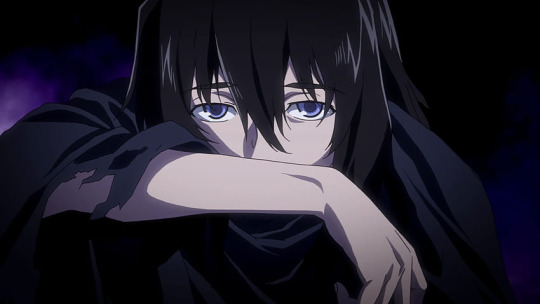
This is, without a doubt, the most common criticism I’ve seen people have of the show. I’m not sure if this is because people are used to the upbeat, overpowered protagonist trope in anime, but people don’t realize that Yukki being frustrating, awkward and terrified is an important part of the show’s storytelling, not to mention relatively unique. Very rarely do we see a realistic portrayal of a teenage protagonist in anime, and it is important for the show since it serves as a contrast to the other characters, all dark, callous and obsessed with the goal of becoming a God. Yukki is the only character not interested in any of this at the beginning. All he wanted was to escape reality with his phone and imaginary friends, and he's now thrusted into this terrible and hopeless situation. How exactly is a young boy expected to react under these circumstances?
Teenagers are naive, dumb, selfish, all characteristics portrayed in Yukiteru, and these characteristics are put under scrutiny by every one of the diary owners, constantly telling him to grow a pair and stop using Yuno. This is easier said than done when you’re used to avoiding every little bit of responsibility in your life, and a girl who’s self-reportedly “crazy good at killing people” suddenly thrusts into your life ready to do all the work for you. Yukki is indeed a very flawed character, but that isn’t an accident, it is an intentional addition. It’s what makes him interesting; it pushes conflict into the show, and most importantly, drives home one of the main lessons of the show with Yukki’s development: fear doesn’t mean you’re not brave, it’s having that fear and pushing forward that makes you brave. A little corny, I know, but a valuable lesson for the Survival Game.
Every character has an incentive for becoming God, and they’re utterly consumed by it to the point of insanity. Even a character like 4th, who was originally concerned with the goal of bringing order and justice rather than more carnage to the game gets carried away when a proper incentive for God’s seat comes into play: saving his son. In a Survival Game where we're surrounded by the most cunning and twisted of characters, killers, terrorists, people in corrupt positions of power, Yukki stands out like a sore thumb for retaining his humanity throughout it all, unwilling to get his hands dirty, rather willing to see hope in everyone else. It comes across as naive and all-too trusting. This is especially true for his father, but considering how little people he has to rely on, plus his childish hopes of seeing his family back together, his forgiveness towards him makes sense. And the same can be said for Yuno, the one constant he’s got all throughout the game. Despite the abuse and manipulation, she’s ultimately got his best interests at heart, but I’m getting ahead of myself with this point.
Eventually, the circumstances that Yukki goes through (namely his parents’ death) put that humanity, kindness and mercy, the staples of his personality, to test. It’s a testament to how desperate situations can corrupt even the most innocent of individuals. Yukiteru goes from a hopeful individual to a callous killer, no different from Yuno and equally as selfish. Similarly enough, we know thanks to her third-world-self that Yuno was originally a normal, happy girl with the hopes of finally having a loving family taking care of her. All of this, to then be tortured by the people who were supposed to bring that peaceful family life to her.
Yukki being a weakling may be frustrating to some, it is certainly brought up many times during the video essay, but it’s an important factor that drives the plot and many of Future Diary’s lessons about growth and accountability. Besides, the anime certainly wouldn’t be as interesting to watch if every character was just an OP know-it-all like Akise. Which no hate to him, but the show wouldn’t be the same if every character were like him.
And speaking of Akise, I’ll take the opportunity to mention a point in the video essay that bothered me a bit. The creator says the show is “queerbaiting” with his character, because Akise’s attraction towards Yukki is forced, but I don’t see exactly how this is queerbaiting. Correct me if I’m wrong, but isn’t queerbaiting when a character is insinuated to be gay, yet it’s kept ambiguous enough to never address it? The show straight-up explains the reason behind Akise’s attraction to Yukki. His love is forced because it was created by Deus to further his investigation about Yukki and Yuno. Akise himself is a fabrication of Deus. It is literally explained in episode 23. You can’t bait the audience into believing a character is gay if you explicitly tell the audience the character is gay lol.
But that’s one of the smaller issues I had with the video’s criticisms. My biggest gripes were actually the following: at the beginning of the essay, this creator talks about how many of the plot points in the show are contrived and illogical, but at the same time, they dislike the characters having tragic backstories that explain how they went on to become twisted individuals. Isn’t it a little contradictory that you complain about a character acting unnatural, yet when the explanation for their behavior comes up, you completely disregard it? They go as far as to say Esuno hates women and is misogynistic for his portrayal of female psychosis, and the use of SA as a tragic backstory being distasteful. Because, according to this creator, people who have been victimized never go on to become terrible people themselves, and that this is a “problematic stereotype.”
To say that this worldview is incredibly simplistic and naive is putting it mildly. Being a victim doesn’t exempt you from the capability of hurting others, and in fact, the opposite is often true. Hurt people hurt people, that is another main theme in Future Diary, and one of the things I love about it so much. It doesn’t make its characters victims of terrible situations for the sake of pitying them, but to portray their natural descent into madness from being corrupted by a cruel and unrelenting world. Yuno, Yukki, Minene, Tsubaki, these characters all started out as normal until life turned them into the nihilistic monsters they became. They’re morally gray, an example of what you can become when your ethics and moral worldview is tested by society so many times, it ultimately turns you into a societal outcast. Which only makes it funnier that one of the questions asked in the video is “are we supposed to like these characters?” Yes and no, that’s the fun of writing morally gray characters.
I often see these takes with people who fail to understand that the portrayal of something in media ≠ endorsement. It’s the crux of people who lack media literacy, the failure to understand morally gray or just straight up evil characters as protagonists. The media itself isn’t telling you to repeat their actions, it is an exploration of how these actions manifest in the first place, a cautionary tale, if you will. I know that having evil or twisted protagonists isn’t everyone’s cup of tea, but to accuse the story or the author of malicious intent would be completely missing the point of the story’s purpose. Not to mention, that it is important for stories like this to exist, to put us in the shoes of those who enact harm, to understand why they do it and keep us from becoming like them.
The show doesn’t justify any of their actions, in fact, it often shows them for what they are: twisted and morally corrupt; it is on the characters themselves to bear the burdens of these actions. A clear example of this is the confrontation that Yukki has with his friends nearing the end of episode 22. It is probably one of my favorite scenes in the entire show: Yukki being forced to face all of his demons at once, realizing just how much damage he has caused, damage that he later has to mend in his final confrontation with Yuno to finally put an end to everyone’s suffering. It is dense, crude, and it is certainly necessary for both him and Yuno.
Funnily enough, this youtuber goes on to say the following about Yuno’s background: “I really don’t care what her (back)story pans out to look like… her actions are still not excusable.” Which is true, just because someone was abused doesn’t justify them perpetuating the same abuse later. However, they then crush their own point by claiming that Yuno’s obsessions started all because of “a passing conversation.” I guess they weren’t lying when they said that they didn’t care about Yuno’s backstory… because chalking up her obsession as solely a result of that scene is completely disregarding her background. That conversation in the classroom did start Yuno’s fixation towards Yukki, but it is not the root of her obsessive tendencies. Yuno herself believes it to be, but this is an idea that is squandered by Yukki in his final confrontations with her. Moreover, if you paid attention to her backstory, you would understand it is all due to her childhood neglect. And similarly, Yukki’s attraction towards Yuno stems from this as well.
This brings me to the final criticism:
“Yuno and Yukki’s relationship is problematic, toxic and makes no sense.”
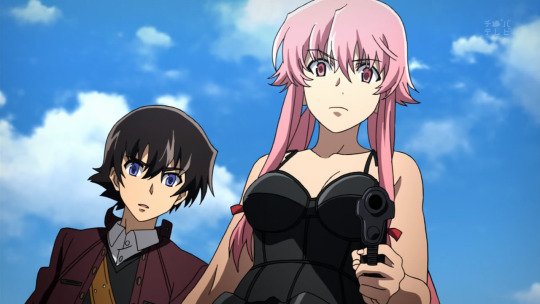
There is no denying that Yuno and Yukki start out as an incredibly toxic and troublesome pairing, using each other for their own selfish wants instead of working with each other. This is the Achilles heel in their dynamic, and it is often the cause of their troubles. Yuno acts impulsive, unstable and manipulative towards Yukki due to her insecurities and debilitating obsession, while Yukki pushes all responsibility to Yuno due to his own lack of a spine. They hurt each time and time again, yet they can’t help but be with each other. And this is because, in a twisted way, they compliment each other.
On one hand, we have a social outcast, ignored by everyone including his family, visibly alone and afraid of being hurt by others, but still seeing the best in people. Then on the other hand, we have a popular girl from a prominent family, visibly perfect, but in reality just as alone due to abuse she experiences at home, making her view people as fundamentally cruel. On the outside they’re opposites, but deep down, they’re both lonely, and terrified of said loneliness. It is only when they meet, when Yukki shows her the kindness she was missing for years and when Yuno gives him the support he had always craved, that they fulfill each other’s needs. By becoming acquainted with Yuno and the Survival Game, Yukki becomes increasingly darker, eventually maturing at the end of the show, while Yukki awakens Yuno’s empathy and pulls her back from the darkness, as we see when she falters to hurt third-world Yuno and her parents.
Their complementary personalities are even referenced by their diaries, which only work seamlessly if paired. They balance each other out perfectly, bringing out the best of each other, but only after learning to push back on their worst characteristics, which is also true for real-life relationships. In truth, just like these two, people are flawed, traumatized and generally toxic to one another. There’s no such thing as people or relationships that start out perfect from the get-go, they need to learn to grow together.
In that sense, this is what makes the ending of the show so powerful to me. Yukki isn’t set on killing Yuno or becoming God anymore. He’s finally taking responsibility, coming to terms with the awful deeds he’s done, and the fact that he can’t undo them. Instead, he wants to help Yuno come to terms with her own demons, finally giving back to her what she needs and not something for his own benefit. Similarly, Yuno realizes just how off the deep-end she’s gone when she meets her past self, acknowledging that she’s lost her original goal, and that repeating the cycle of hurt won’t fix her already broken spirit. That world isn’t for her, and so she finally ends the hurt, giving her and Yukki the peace they need.
Many people don’t like Redial because they see it as an undeserved Happy Ending for two awful individuals, but the way I like to see it is as a form of redemption. Both characters, in the end, do what they have to do to restore order in the world. Yukki pays for his sins in the void, finally a God but at the cost of mourning what could’ve been. First-World Yuno ends the suffering she’s putting herself through so her new self can thrive, almost akin to breaking free from her past traumas to finally heal. The new self regains those memories, not to sulk, but to build from them, going back with Yukki to start a new world that isn’t characterized by their original hurt. In a way, it's a story about how the most downtrodden of individuals can find solace in love, break from their past and learn to heal together. For me, it’s cathartic and fulfilling to watch.
To finish this lengthy post, I feel it’s appropriate to mention the importance of Future Diary’s characters, and more specifically, Yuno. The video describes her writing as shallow and contrived, but I’ve already addressed that in the previous paragraphs. Many people love chalking her up to “cRaZy YaNdErE gUrL™ 🤪,” but she’s so, so much more than that. Her character actually has a lot of depth if you pay attention to her story: she’s a girl, an orphan who went on to be neglected by her foster father and abused by her foster mother, resulting in complex trauma, insecurities and fear of abandonment that she tries to hide and overcompensate for in her overly aggressive tendencies. Her obsession in avoiding the loss of the only person she has becomes her demise, as she lives in a loop of torment all for the sake of not being alone again, a cycle of hurt only she has the power of breaking if she finds the strength to do it. Whether it was intentional or not, Yuno portrays a lot of the issues people with mental illness, such as BPD, struggle with.
Now, claiming that Yuno is a perfect, one-to-one representation of BPD would be reducing this disorder to a caricature, there’s obviously so much more to BPD than what you see in this portrayal. But, I feel like out of the huge list of characters that fall under the “yandere” or crazy girl trope, she’s probably one of the best written ones in anime. I know she’s often dubbed the “yandere queen,” but seriously, it’s rare to see media committing to this trope and properly characterizing it. I would go as far as to say she’s the best character I’ve seen written in this genre, only sharing that spot with another character from a certain game (but given that the mere mention of its name is enough to ensue controversy, I’ll abstain from talking about it here 🙄). A big portion of characters within this trope are quite two-dimensional, without clear motives for their obsessions, or having their issues played up for laughs (I’m looking at you, Anna Nishikinomiya). Heck, many of the characters associated with the trope aren’t actual yanderes, like is the case for Shion Sonozaki or Lucy from Elfen Lied.
Yuno’s character is rich and interesting to watch, she isn’t just some “crazy girl” for the sake of it. She’s a product of tragedy, only motivated by the hope of finally having Yukki alleviate all of her insecurities and sorrows. I’ve always found the “yandere” trope interesting since it delves into the lengths people are capable of going over an obsession, and how these form to begin with. Given how complex, sensitive and even personal this topic can be, it’s important to have characters like this be properly written, and I’m glad that Yuno set a standard for this back in her day, even if many people don’t take her character seriously.
I think it’s important to close up this post repeating the sentiment I had at the beginning. My purpose in writing this defense isn’t so much to force people into liking the show, and even opinions I disagree with like the ones in NezumiVA’s video are valid in their own right, as everyone has different perspectives in interpreting media. This is simply my take as someone who’s been a fan of the show for a really long time, since I don’t see many in-depth essays for Future Diary out there. It is a show that has stuck with me for its lessons on learning to be brave, healing from the past and selfless love. As silly as it may sound talking about an anime, it’s something that I can always look back to and smile, laugh or cry along with. Despite people’s conflicting views and endless criticisms, it will never fail to have a special place in my heart. Given how much time I’ve dedicated to this series, it’s only fair I dedicated a little bit of that time explaining my love for it too. And if you made it this far down the post, I would also like to thank you for dedicating a little bit of your time to my shower thoughts as well!
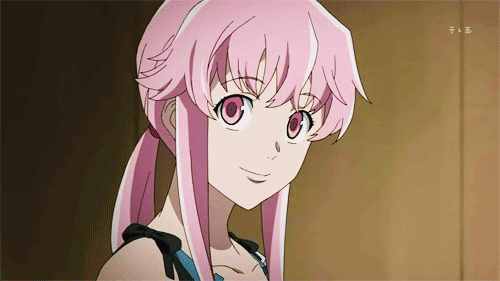
#future diary#mirai nikki#the future diary#anime#yuno gasai#yandere#sakae esuno#essay#anime essay#long post
37 notes
·
View notes
Text
A Lily Gilded: A Review and Analysis of Undertale Yellow

The Short, Spoiler-Free Review (TL;DR)
Any Undertale fan who owns a PC should play Undertale Yellow, even if they previously weren’t interested or have any doubts or reservations.
No criticism that I levy at Undertale Yellow, big or small, is intended to dissuade anyone who hasn’t played it from trying it: you should play it and there is no reason not to aside from a lack of free time or not owning a PC.
Although I have some criticisms of Undertale Yellow, my overall opinion of it is still very positive. I’m glad to have experienced this game.
If you haven’t played the game yet, then I recommend starting with the neutral route. Pacifist is much harder in this game and there are story segments exclusive to the neutral route that make it worth the time investment.
My analysis from this point forward will include spoilers for all three major routes of Undertale Yellow. It will also be very long (close to 60 pages), so be warned.
My Background
I’ve completed all routes of Undertale, Deltarune (Ch 1-2), and Undertale Yellow
I primarily engage with UTDR fandom by reading and writing theories. I like to think that I’m decently knowledgeable about the series, at least
I have no professional background in game development
I’m usually a purist when it comes to games and the topic of fangames and mods. I’m a “picky eater” in particular when it comes to UT/DR fan content:
I’ve never played an Undertale fangame prior to Yellow
Most UT and DR fangames have either not appealed to me personally or have not been finished
I don’t engage with most story-driven Undertale/Deltarune Aus or fanworks if I feel they don’t capture the spirit of the original games
Saying Something Nice
Undertale Yellow is the best fangame that I’ve played in recent memory. I think it’s very likely that Undertale Yellow is not only the best Undertale fangame ever made but that it will remain the best Undertale fangame of its kind for the foreseeable future. It’s not just a good fangame but a good game in general--had Undertale Yellow been a completely original game with no ties to Undertale, it very likely would have become a cult classic in its own right.
Of the long-form fan content I’ve seen, Undertale Yellow is among those that come the closest to replicating the style and tone of the original game without feeling like it’s simply cribbing the story or jokes.
It goes without saying that Undertale Yellow’s spritework and animations far surpass those of Undertale in sheer effort, and at times they rival and surpass those of Deltarune as well. There are some stylistic differences between Yellow and the canon games, and I wouldn’t go so far as to say Yellow’s visuals are always better in every conceivable aspect, but the general quality difference is night and day.
Yellow’s music comes close to rivaling Toby’s work, though frankly I think this is a barrier that no fangame will ever overcome for me. It’s a better impression of Toby’s style than most who’ve tried, but it’s still noticeably an impression. One thing that I immensely appreciate is that Yellow has battle theme variants for each major area in the game. “Enemy Approaching” is a fine song, but I always start to get sick of it by the time I reach the end of Waterfall in the original game.
Most of all, what I respect about Undertale Yellow is when it shows restraint: the restraint to largely omit cameos and callbacks to Undertale’s characters except when it feels warranted to do so. I respect that the game doesn’t try to smuggle in characters or worldbuilding elements from Deltarune and instead sticks to its guns as an Undertale prequel. I also appreciate that, for the most part, it sidesteps the trap that most prequels fall into of trying to tell a bigger story than the original—the story of Undertale Yellow still feels impactful and meaningful, but it does not overshadow or diminish the events of Undertale.
I wanted to frontload my praises for this game because a lot of my more detailed analyses to follow will come across more negative and nitpicky. Admittedly, it’s much easier to point out something that doesn’t work in a story or game that’s otherwise good because it sticks out like a sore thumb and takes you out of the experience. Additionally, so many things are done well in this game that I’d be here all day if I listed every single thing that worked. If there’s an aspect of the game that I don’t comment on then just assume that I found it at least serviceable, if not great.
My Criteria
Since Undertale Yellow is based on the world of Undertale and borrows many gameplay elements from it, it’s virtually impossible to review or analyze the game without inviting at least some comparisons to Undertale.
Having said that, I’m going to avoid criticizing differences between Yellow and the original game if the criticism would boil down to “it’s different from Undertale, therefore it’s bad.” There are things that Yellow does differently that I find worse, but I’ll argue those on their own merit rather than pointing solely to the fact that they’re different. On the flip side, there are a few places where Yellow differs from the original game because Yellow does something better—I’ll be sure to point out these instances as well.
Overall, I’m grading Undertale Yellow on a curve because I can’t help but compare it to the original game. I don’t feel it’s unfair for me to do so, since Yellow relies on Undertale not only for its conceit but also for some of its story beats—Yellow would not make sense or feel complete as an experience if Undertale did not exist.
If Undertale Yellow had been a completely original game, with whatever tweaks or rewrites would have been necessary to make it such, my overall tone would probably be more positive, since I’d be comparing it to the average game experience rather than to one of my favorite games of all time. This is not to say that Yellow would have necessarily been better as an original game, nor am I saying that it should have been—it just would have made the comparisons to Undertale less warranted.
Lastly, I’m going to try to avoid comparing Undertale Yellow to Deltarune. I feel like this is a less fair comparison since Deltarune is not a finished game and Yellow lifts very little from Deltarune beyond a run button and the charge shot.
Bosses
Undertale Yellow’s bosses were the most contentious issue for me during my initial playthroughs. Subsequent playthroughs caused me to warm up a bit to some of the problematic ones, but most of my gameplay-related gripes are tied to its bosses.
My three biggest issues with this game’s bosses are the strategies for sparing bosses, the telegraphing of their attacks, and the attack variety that each boss has.
Sparing Strategies
To start with the simpler complaint, half the bosses and minibosses in this game have pacifist fights that consist of waiting for the boss’s dialogue and attacks to run out before you can spare them, sometimes requiring a token act only at the very end of the fight.
This is a problem because it reduces these fights to waiting games that can be brute-forced with a full supply of healing items. Annoyingly, these same fights also come with 2-3 options in the ACT menu that often do nothing and in most cases don’t even prompt any reaction or different dialogue from the boss.
By comparison, Undertale’s pacifist route only has two (and a half) bosses that require waiting out the opponent: Papyrus and Muffet, and both of these fights have alternate completion conditions that can be used to bypass the wait.

Conversely, Napstablook’s fight requires acting, Toriel requires constant sparing, the Snowdin dogs all have unique acts, Mad Dummy requires redirecting her attacks back at her, Undyne requires running away, the Royal Guards require acting, Mettaton must pass a ratings threshold tied to unique acts, Asgore and Flowey require fighting; Asriel’s fight is half waiting but the second phase requires the lost soul segments to be completed.
Every Undertale boss felt like a puzzle on pacifist and some like Undyne and Mad Dummy were genuine brain-teasers. None of Yellow’s fights ever quite scratch that itch, though a couple come close like Guardener and Axis.
It baffles me a little that this issue is even present because the common enemy encounters in Yellow don’t fall prey to this. In fact, a few enemy encounters in Yellow cleverly require using multiple different acts in a specific (and usually intuitive) order to achieve victory—something that even Undertale seldom did.
It seems that most bosses in Yellow were designed around distinguishing themselves via their attack patterns rather than their spare method, though this leads into anther major issue: how these attacks are conveyed, paced, and telegraphed to the player.
Attack Telegraphing
Undertale Yellow is meant to have harder combat than Undertale, which had me a bit wary going in. The average enemy encounter in Yellow feels harder than Undertale, and the same is certainly true of the bosses. However, I’m not sure if I’d say any of Yellow’s hardest bosses quite rival the Sans fight in terms of sheer difficulty, at least in terms of the number of attempts it took me to complete them.
This could be chalked up to me coming into Undertale Yellow with more experience than when I first played Undertale, or Yellow’s 1.1 patch toning down a few of the harder fights. For the record, I’ve beaten all fights in Yellow without the use of the game’s “easy mode” option—I used it for certain bosses in my very first pacifist and no mercy runs, but I later replayed those runs with the setting disabled in order to have a “proper” experience.
Many fights in Yellow, big and small, feel less “fair” than the fights in Undertale and even now I’m not 100% sure I can nail down why. A lot of this boils down to the “feel” of the fights, but part of this could be due to me already being familiar with Undertale’s attack patterns and not Yellow’s. OG Undertale does have a handful of battle moments that feel “unfair” or not designed as optimally for new players as they could have been, which is easy for a player like me to gloss over after I’ve become familiar with the game. One such example is the Lemon Bread amalgamate, which (imo) is one of the hardest fights in the pacifist route.
Still, I noticed many instances in Yellow where incoming attacks would give little or seemingly no warning before they were able to hurt you. Some examples off the top of my head would be Mooch’s moneybag attack, Guardener’s triple stomp attack that fills the whole box, Starlo’s horseshoe attack that blends into his head before it drops, and Ceroba’s paralyzing diamond attack.

The only consistent way I found to avoid attacks like these was either to know in advance where they were going to enter the bullet box or to already be moving before they appear. It doesn’t help that often attacks that come from outside the bullet box will spawn in immediately outside the box, minimizing the travel time where players could see them coming and act accordingly.
Another common issue I found is the frequent use of blue and orange attacks, often paired with each other and/or with regular attacks, and often without properly telegraphing which will be used until they’re already onscreen. In contrast, Undertale generally used these types of attacks one at a time or, in Asgore’s case, clearly telegraphed them before they were used in tandem.
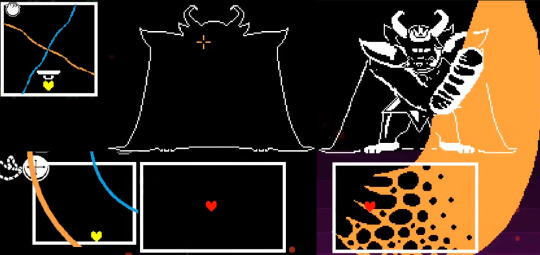
Yellow’s approach presents a problem because dodging orange and blue attacks demands either movement or lack of movement, which can force the player to take a hit if there’s already another attack onscreen that demands the opposite. In my experience the solution was either to know in advance where the blue and orange attacks would come from (and when) to get into optimal position, or simply tank the hit and hope you make up for it later.
Speaking from my own personal experience, I struggled for a time with Ceroba’s No Mercy fight when I went in blind—she has multiple deadly attacks with little to no telegraphing as well as color attacks that can overlap each other if you’re not already in an optimal position. I was only able to complete this fight on normal after I watched a no-hit run so that I could memorize her patterns. This is something I’ve never had to do for any Undertale or Deltarune fight, including Sans, and it doesn’t really feel like it’s in the spirit of the franchise. I always try to go into each of these games blind and I don’t think it’s unreasonable that a new player, even on a harder route, should be able to intuit what is expected of them in a fight. A few attacks might be challenging or counter-intuitive at first, but having to rely on rote memorization or a guide just doesn’t feel fun or organic to me.
On that note, some of you may be nodding toward the Sans fight as an example of some of the things I’m complaining about, particularly the lack of proper telegraphing and a reliance on memorization. Well, let’s unpack that.
To start, I’ll say that the Sans fight is not my favorite fight in Undertale from a pure gameplay perspective and that I don’t fully agree with some of its design choices. One reason I don’t play fan battles in general is because many of them seem to emulate the style of the Sans fight or double down on it without understanding it.
Despite my minor issues with it, I find the “unfair” aspects of the Sans fight to be more justified and acceptable within the context of Undertale than I find the seeming “unfairness” of Yellow’s harder fights to be in the context of that game. One reason is that the Sans fight is the only fight in Undertale (or Deltarune) that works the way that it does, whereas Yellow has several, even if they’re overall less hard than the Sans fight.
More importantly, the Sans fight has proper buildup, feels appropriate for the character and story, and (most important of all) the game itself acknowledges the fact that it’s unfair and the fight is designed around that admission. Sans literally has over a dozen different dialogue variations depending on how many times you die in his fight and when.

The game is even aware of the fact that most new players won’t survive Sans’ first attack and creates multiple variants of just the dialogue before and after that attack. Undertale fully anticipates your deaths and cultivates a unique experience for you along the way as you learn Sans’ patterns.
To put it simply, the Sans fight is the exception that proves the rule: it makes you realize how much fairer the other fights in Undertale are and how easy it is to take those design principles for granted. Conversely, the attack patterns in the hardest Yellow fights didn’t feel radically different or radically “less fair” in philosophy from Yellow’s moderately difficult boss fights—both feel varying degrees of “unfair,” but the harder fights are just “more” with the occasional twist added on top.
My platonic ideal of a challenging boss fight in an Undertale game would be Undyne the Undying. Undyne the Undying is a massive difficulty spike in her respective run, at times she requires ridiculous reaction time, and it’s easy to psych yourself out and get double-tapped by her barrages and die quickly. Nonetheless, her fight feels fair—it’s a culmination of the rules you’ve been taught and it doesn’t needlessly subvert them. Even though she has her dreaded reverse-arrow attacks that trip up new players, these are still properly telegraphed and manageable. Looking at footage of it now, it’s surprising how this fight looks more honest and straightforward than many of Yellow’s later boss fights.
Attack Variety
Another contributing factor to my issues with Yellow’s boss fights is the sheer number and variety of attacks that some bosses have, particularly in the latter half of the game. To wit, most bosses in Undertale have about 4-5 unique attacks that are repeated with variations, while Undertale Yellow’s bosses can have upwards of 9-10 unique types of attacks, not including variations. Ceroba alone has ten completely different unique attack patterns in just the first phase of her pacifist fight—every single turn is a completely different attack requiring different dodging strategies and none are repeated.
Some may be asking why this is a problem. Isn’t more variety a good thing? This just shows that the Yellow team put more effort in, right? My issue here is that many of these attacks don’t seem to exist for any reason except for the sake of artificial variety and because the devs (presumably) thought they’d be a cool-looking thing to dodge. If you’re confused as to the point I’m trying to make, let’s look at how Undertale utilized its attack patterns with Mettaton EX.
The Mettaton EX fight is a favorite of fans and mine, and one reason I like it so much is for how it uses eclectic and seemingly chaotic attacks to teach the player new mechanics while offering a spare mechanic that relies on strategic thinking to optimize. The fight offers the following types of attacks: moving legs, bombs, boxes, miniature mettatons, gates, a disco ball, and Mettaton’s heart. Not counting the joke/gimmick turns like the essay or break time, this is seven main attack archetypes, each with their own variations and crossover with each other.

Note that all seven of these attack types interact with the fight’s core mechanic: the yellow soul mode. More importantly, each of these attacks teaches the player something about how the soul mode works with no need for an onscreen prompt. Boxes and bombs teach you that there are some attacks you should shoot and some that you should not. The hand gates initially teach you that some bullets are unaffected by your shots, but later you’re given gates with yellow buttons that will open them, teaching you that some targets require precision. The miniature mettatons teach you that some attacks will become a bigger problem for you if you don’t take them out right away. The moving legs teach you that shooting can stop certain attacks from moving and that the timing of your shots is important. The disco ball builds on this lesson, requiring the need to plan your next movements when shooting the ball. The heart serves as the culmination, featuring the bombs and mini-mettatons from before while also giving you a precise moving target to hit repeatedly.
All of Mettaton EX’s attacks tie into a common theme and reinforce one another—learning to dodge and utilize the mechanics of one attack will make you better-equipped to deal with the others. It’s by no means a perfect fight, nor does it teach all of its lessons perfectly—I remember it taking me several attempts to complete and some mechanics like the disco ball and legs didn’t “click” with me immediately, but there’s clear intent behind every attack and it’s remarkable how utilitarian the whole thing is structured, despite its reputation for being one of the game’s longer and more self-indulgent fights.
Let’s bring things back to Ceroba for comparison. Her first phase has 10 unique attacks, only half of which feature mechanics that appear in the later phases: her paralyzing diamonds, her spinning bullets that circle around you, her bells that create colored shockwaves, and the vortex that opens in the center of the arena.

The other attacks are only used once, have little-to-no pattern commonality with each other or with her later attacks, and teach nothing other than how to dodge each of these one-off attacks. At most, a few attacks share a flower motif but move with completely different behaviors (straight line, fanning out, circling, homing in). While this isn’t horrible design, I can’t help but find it a bit wasteful considering what other fights have done with less and how chaotic the later phases of Ceroba’s fight get—something that players could have been eased into by having her first phase present more of her later attacks in a more controlled environment.
In the end, I remember being frustrated with the Ceroba pacifist fight when I first played it. Part of this was due to my own mistake of going past the point of no return without a full stock of items, but the lack of cohesion in the first phase and its lacking relevance to the mechanics of the second phase made it hard for me to “gel” with the gameplay and, as a result of my own frustration and confusion, I had a harder time getting invested in the narrative. I’ve seen some fans label the Ceroba fight the best fight in the series, but I wouldn’t even put it in my top 25, despite the overwhelming effort on display from the developers.
To bring the comparison home, I cried the first time I saw Mettaton say goodbye to his call-in viewers, but not once did I cry during Ceroba’s fight. A flamboyant robot making a single pained expression leaves a bigger impact when his attacks are unintrusive to the experience, and a lovingly-animated grieving fox’s backstory doesn’t hit as hard when I’m distracted by a hodgepodge of visually stunning but incoherent bullet hells. Less is more.
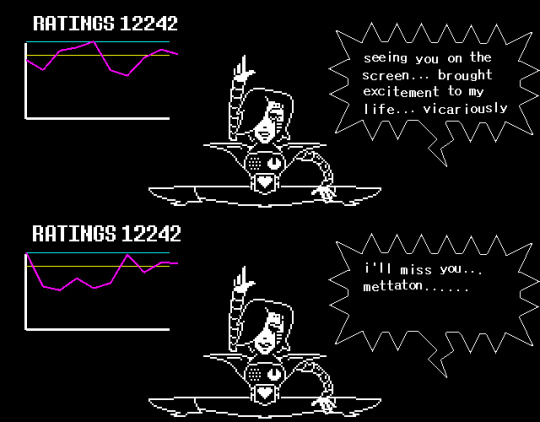
I realize I’ve been a bit mean to Yellow during this segment. In fairness, I did replay the pacifist route and tried the Ceroba fight in a more prepared state. I enjoyed the fight more my second time around, but I still would not rank it among my favorites in the franchise. And to be clear, I don’t hate this fight at all—I just think it represents the excesses in Yellow’s battle design and how they can sour a first-time experience, which is the most important experience for a narrative-driven game. Even the weaker aspects of Yellow’s design are, by and large, serviceable by the standards of typical game design. Compared to Undertale, though, I was disappointed in the areas where it lacked or, more accurately, overstepped.
Having fewer types of attacks is not a result of less effort—it allows more room for variations on each type of attack and it can make difficult or poorly-telegraphed attacks more forgivable if the attack is used multiple times with the first instance training the player for the future variations. I feel that having too many unique attacks for each boss resulted in each attack not receiving the necessary polish and balancing that it should have, and it also made each fight feel less instructive and lacking in a clear design goal.
To close this off, I’d like to give a positive example of a boss fight from Undertale Yellow: Axis. For the most part, Axis successfully walks the tightrope of Yellow’s more complex late-game fights while still maintaining a consistent theme and introducing concepts to the player gradually. The whole fight revolves around blocking Axis’ attacks with a trashcan lid—first with a ground-based lid, then with a lid that rotates around an axis (get it?). As the fight progresses, new types of projectiles and hazards are introduced, usually first using the ground-based lid to avoid overwhelming the player.
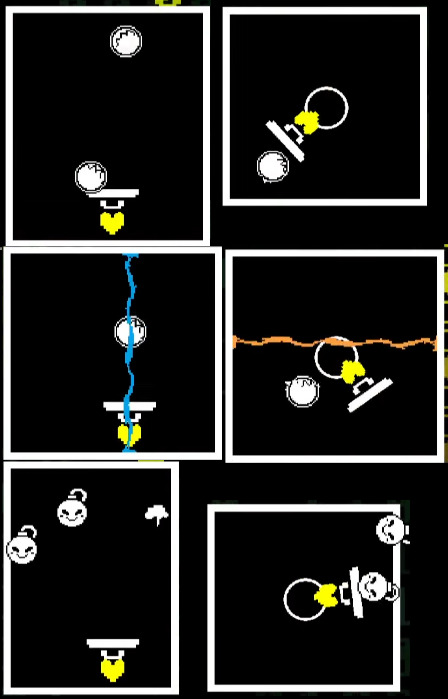
As if that weren’t enough, the fight comes with its own unique sparing strategy where players fill a meter by blocking attacks and then attempt to reflect an orb back at Axis once the meter is full. The fight’s not perfect—there’s still the occasional one-off attack that doesn’t really teach any relevant lesson to the player, the orb reflection mechanic is finicky, and the fight is perhaps slightly more difficult than I’d prefer from a typical boss fight, but if all Yellow bosses had been of a similar caliber then I wouldn’t have needed to go on this massive detour about boss design in the first place.
Since some might ask, I might as well weigh in on Yellow’s most controversial boss: El Bailador. I initially had difficulty with this fight due to my lack of experience with rhythm games (and the lack of preparation that the game gives you). I also found the need to press a direction key and the Z key for each note to be a tad clunky. Beyond that? I actually didn’t mind the fight all that much. It introduces a simple concept and builds upon it gradually in a way that felt satisfying to me as I began to master it. The last turn maybe goes on for too long, but I can’t say that I hated it. I promise I’m not trying to piss off the Undertale Yellow fandom (who, if memes are anything to go by, seem to despise this fight), but I found the simplicity of Bailador refreshing considering how chaotic the later fights get. That said, I turned on the auto-rhythm setting in future playthroughs to make this fight less of a difficulty spike.
Themes
To start off, I’d like to acknowledge the fact that Undertale Yellow largely avoids most of the “meta” themes that Undertale and Deltarune touch upon, nor does the game try to go in its own direction in regards to metatextual concepts. Undertale Yellow generally leaves the topic untouched, aside from continuing to use in-universe mechanics established in Undertale such as saving and EXP/LV. Some fans might view this as disappointing or even a betrayal of the tones and themes previously established in Toby’s work. Me? I don’t mind at all, honestly. If anything, it’s refreshing to see an Undertale fan project that takes the setting of Undertale at face value rather than trying to outsmart it or put their own meta spin on it. Far too often have I seen fanworks that swing the pendulum in the other direction and have characters just flat out address the player and shatter the verisimilitude of the setting with no buildup.
None of this is to say that Undertale Yellow is lacking in themes. The most prominent theme I noticed, unsurprisingly, is that of justice. Undertale strongly implies that the yellow human soul is the soul that represents justice, and fanworks ever since have ran with the idea. Undertale Yellow represents the culmination of this concept by turning each of its routes into differing interpretations of what justice means.
As a refresher, Undertale Yellow has three main routes with four endings: true pacifist, “false” pacifist, neutral, and no mercy. I see each ending as its own realization of and commentary on the concept of justice.
Neutral
In Undertale Yellow, the neutral ending acts as something of a “bad ending” from classic video games. These are the kind of endings you get when you fail to 100% complete a game and you’re told to go back and do it again, complete with Flowey’s laugh imposed over the “Thank you for playing!” end credits message.
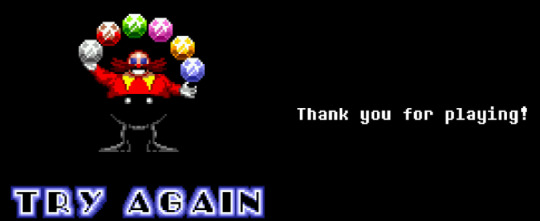
Who wore it better?
Thematically, the neutral route represents justice as subjective and personal—Clover can spare or kill whoever they wish. It’s hard to argue that any one monster in Undertale Yellow is more guilty than any other in this route, so killing monsters in neutral largely comes off as the capricious whims of Clover rather than being based on any consistent law or greater principle.
This outlook ultimately blows up in Clover’s face when they come to a head with their foil in this route: Flowey, who exercises his own form of justice, or “judgment” as he prefers. Flowey only cares about freeing himself from his current situation and will use any means to achieve this goal. In his eyes, your failure to follow his directions or be of further use of him is a slight against him that demands punishment as he sees fit.
Fitting this individualistic outlook, Flowey takes “might makes right” to its logical conclusion by trapping you in his own personal hell while he acts as a wannabe-God looking down on high. Ultimately Clover can only escape when Flowey wills it, cementing Clover’s status as a pawn subject to the whims of the powerful despite their illusions of independence. Without laws to protect them, the weak will be trampled by the powerful.
Pacifist
Pacifist presents two outlooks depending on whether Clover spares or kills Ceroba in the final battle. Of all the monsters Clover meets, Ceroba is the most culpable for a serious real-world crime other than Asgore and Axis (the latter of whom may not meet the definition of culpability or competence to stand trial).
Clover lacks the fore-knowledge that Ceroba’s daughter will likely survive thanks to Alphys’ efforts, so Clover would view Ceroba’s actions toward Kanako as manslaughter, or at least reckless endangerment. Unlike the neutral route, Clover’s choice can’t solely be chalked up to their own personal whims—actual harm has been done by Ceroba, but more harm may yet be done if she’s killed.
False Pacifist
If Clover kills Ceroba, then this choice seems to represent justice as following the law to the letter, for good or ill. Starlo, who’s most upset by Ceroba’s passing, reluctantly echoes this sentiment:

Even if Clover stands by their choice deep down, it’s reasonable to assume that hurting Starlo this way left a bitter taste in their mouth. Not long after this, Clover reaps what they’ve sewn as they come face to face with their foil for this ending: Asgore.
Initially I thought it was strange that Asgore doesn’t appear if you spare Ceroba, but this ending illustrates why Asgore’s entrance is most appropriate here. Asgore finds himself in a similar situation as Clover. Asgore is keeping his word to his people for good or ill, and a king’s word is law. In all likelihood, Clover probably hated killing Ceroba in much the same way that Asgore hates killing humans. But both are trapped within the confines of their own rigid principles.
Martlet, who acts as an onlooker, first argues on behalf of Clover’s killing of Ceroba on the basis of the law, but just as quickly turns around to plead that Asgore bend the rules of his kingdom to spare Clover. In the end, she can’t have it both ways. No one is happy with how things turn out and the only thing served is the letter of the law, rather than the spirit of justice.
True Pacifist
If Clover spares Ceroba, it might be for her own sake or because killing her will benefit no one and will only serve to harm Starlo. In much the same way, killing the monsters who harmed the five humans won’t bring any benefit to monster or human alike and will instead only fan the flames of war.
Clover came to the Underground armed in search of five humans, no doubt willing to enact justice on anyone or anything that harmed them. Instead they find a world of good-hearted people who have ample reason to distrust humans. Through acts of kindness, this distrust is cast aside and many friendships are made.
In the Wild East, Clover is presented with the classic trolley problem. Starlo emphasizes that Clover could let a large group of monsters die while incurring no personal responsibility. Clover didn’t tie those monsters to the tracks in much the same way that Clover is not personally responsible for monsters being trapped Underground. However, Clover can save them by sacrificing a single life—an anonymous other, but eventually Clover is faced with the possibility of becoming that sacrifice willingly.

Clover choosing to give up their soul is not only an ultimate act of selflessness but also interprets justice as a principle higher than any mere law or person’s whim—laws should not exist solely for their own sake because laws should be a means for the betterment of all. Any “justice” that loses sight of this higher principle has no meaning or value, so one must act in service to the greater good.
Clover doesn’t deserve to die, but sitting on the sidelines so that monsters or the next fallen human can suffer in their place would be a greater injustice in their eyes. Ultimately they decide that their own sacrifice, while tragic, will create the best outcome for everyone and act as a step towards restorative justice for monsterkind.
No Mercy
No mercy was a bit of an enigma for me initially. It starts off largely the same as Undertale’s no mercy route, only without the one-shot kills and commentary on completionism. It’s not until Steamworks when the aim of this run starts to come together. We see a role reversal where Clover chases down Axis, and Flowey of all people questions Clover’s craving for destruction.
When fighting Axis, we see him admit that he had killed a previous fallen human. Although this information can be uncovered through a hidden tape in the pacifist route, here we see this revelation enrage Clover to the point that their LV increases on the spot. Normally I’d nitpick something like this, since Undertale states that cruel intentions can make a human’s individual attacks stronger but their LV is tied to their EXP. However, I can overlook this since the rules are bent in service of a good character moment that defines the run for me.
This moment and the ending recontextualize the whole run up until now: Clover isn’t killing indiscriminately like Frisk was. On the contrary, Clover is quite discriminate with their killing: they specifically want monsters (and their creations) destroyed, but not humans. Up until now we haven’t had an Undertale protagonist who is unabashedly pro-human. Chara was very much the opposite and some lines in Deltarune imply Kris may feel similarly. Frisk seems ambivalent, but from the beginning Clover has been acting for the sake of the five missing humans.
In neutral and pacifist, Clover judges monsters on an individual basis, but in no mercy all monsters are deemed guilty. What distinguishes this run from the others, besides the brutality of Clover’s actions, is that their actions can’t solely be chalked up to dogmatic obedience of the law or their own selfish desires.
Throughout the run, Clover can choose to steal from shops, commit armed robbery against Mo, and even cheat in their “dual” with Starlo—all of these indicate some degree of underhandedness or dishonor, but Clover’s outlook is seemingly that monsters don’t deserve fair play or the benefit of the doubt.
Conversely, we see from the ending that Clover goes out of their way to free the five human souls—they don’t leave them behind or try to go on a power trip and use them for their own ends (as far as we’re aware). No mercy is a dark reflection of true pacifist, where “justice” has transcended the letter of the law as well as personal desires. Instead of “justice” being in service to the greater good of all, it’s in service to division, tribalism, and vengeance.
Even so, one can debate whether Clover’s actions are motivated more by a love of humanity or purely by a hatred of monsters. Asgore points out that Clover’s actions will only worsen the conflict between humans and monsters, and more humans will die in the future as a result.
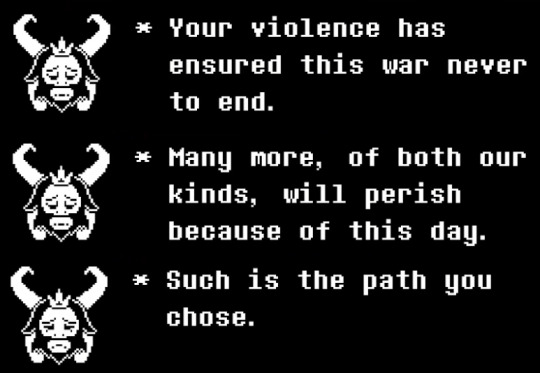
This doesn’t seem to give Clover any pause, so one can assume they either don’t believe Asgore or they don’t care—they’re here to make monsterkind pay, and if more conflict arises then that means more opportunities for payback in the future. Make them pay and never stop making them pay.
Characters
Character writing is a crucial component of any Undertale-adjacent game and it’s often the biggest stumbling block I encounter when I’ve tried to get into fanworks. I mean that in no way as a slight against fan creators, but rather to illustrate how high the bar has been set by Toby. This is a bar that’s set just as high, if not higher than Toby’s musical abilities, imo. In all the ways that I would describe myself as a “picky eater” when it comes to Undertale content, I’d say character writing is where I’m by far the pickiest.
To give Undertale Yellow a fair and thorough analysis, I’ll be going over all of the major characters one by one to give my impressions of them as well as what I feel works and what doesn’t, starting from the top:
Clover
There isn’t a ton to say about Clover compared to the other characters, but this isn’t a bad thing. What’s apparent is that Clover has more personality and initiative on display throughout the game than Frisk did, though in some ways not as much as Kris—Clover is something of a middleground between the two canon protags. At several points we’re only given a single dialogue “choice,” meant to illustrate when Clover has made a decision on their own.
We’re told Clover’s surface-level motivation: to find the five humans who disappeared, but we’re not given any context as to what connection (if any) Clover has to these humans or what their own history is beyond one or two vague bits of flavor text.
Clover’s motivations can evolve or outright change course depending on which choices the player makes throughout the game. I already went over this in the themes section, but the fact that Yellow largely eschews the broader metatextual commentary found in Undertale means that Clover’s actions are much easier to attribute as their own in-universe decisions, rather than something imposed on them by a controlling entity.
Beyond this, we also see Clover display various quirks via their character animations, such as kicking their feet while seated, tugging on Ceroba’s sleeve, or standing on their tippy-toes when handing their hat to Martlet. We ultimately can’t say much about Clover’s overall personality or interests outside the context of game events, but these little flourishes help to make the character memorable.
By default I’d argue that Clover’s “better written” as a character than Frisk was, barring the metatextual baggage attached to the latter. Overall, not a bad start.
Dalv
I wasn’t sure what to make of Dalv initially. Confession time: Dalv was the deciding factor that led to me not checking out the Undertale Yellow demo when it first dropped. I’ve got nothing against the guy, but at the time I didn’t really “get” his character—I wasn’t sure what his motives were and I couldn’t even understand what his first lines of dialogue were meant to convey.
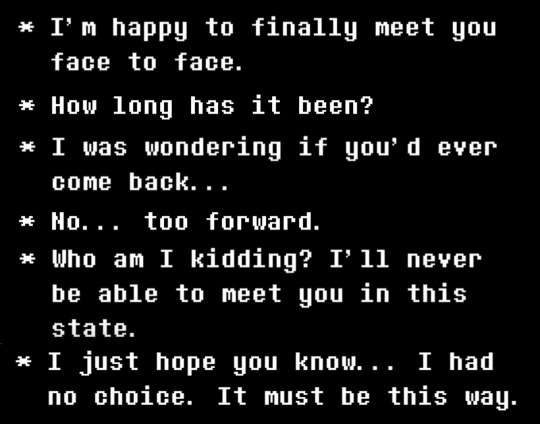
Even now I’m still not 100% sure whether his first line of dialogue is him rehearsing a conversation with another Ruins monster, with the monster that used to leave him corn, or with the previous human that he encountered. The fact that Dalv is known by the other monsters for talking to himself and having imaginary friends only blurs the lines further, though this doesn’t feel intentional.
This is part of a broader, though minor, issue with some of Yellow’s writing where characters will allude to events and other characters that a first-time player wouldn’t be familiar with. To be fair, Undertale does this as well early on but usually with enough context clues to help you figure things out—Papyrus namedrops Undyne and Alphys in Snowdin, but we learn from context clues within Snowdin that Undyne is a monster of authority that Papyrus knows and Alphys is a doctor and apparent inventor.
To draw a more direct comparison, we know early on that Toriel is a motherly figure and we see in her house that she has taken in other children who’ve met an unknown fate—this mystery leads to some first-timers speculating whether Toriel is the one responsible for said fate. Right before her boss fight she explains her motives more clearly--her actions, though overbearing, have been to protect Frisk. You can also infer, though not stated directly, that her actions towards Frisk may be some attempt on her part to recreate or make up for her past experiences with children that she’s lost. Later on we learn that she’s Asgore’s ex-wife and lost her two children tragically, but this is not something that needs to be spelled out in order to get a basic grasp on Toriel as a character.
Dalv, on the other hand, has an implied backstory that is never outright stated but instead needs to be pieced together from context clues given much later in the game, some of which are tied to optional secrets and randomly-generated fun events. In short, Dalv was a monster living in Snowdin who met Kanako when she and Chujin came to visit. During that visit, Dalv was attacked by a human (implied to be the one carrying the blue soul), who was later killed by Axis. It’s implied that this experience was so traumatic that Dalv retreated into the Ruins and cut off all contact with those around him. Conceptually? This is a solid backstory. No notes. It’s a shame, then, that most players don’t even seem to be aware of it after finishing the game.
Now, a character doesn’t need a tragic backstory in order to be likable or compelling. In fairness, I do enjoy the aspects of Dalv’s character that are given upfront in his house—his neatness, his social awkwardness, his creative side, and his “imaginary” friends. The problem is that we don’t see these sides of him until after his boss fight, when most players likely won’t see him again for the rest of the game.
Characters don’t need to front-load their entire personality or backstory into their first encounter, but doing the opposite isn’t helpful either. First impressions matter in fiction, and unfortunately Dalv gave very little for me to latch onto for most of his screentime. It’s really only through hindsight that I began to appreciate Dalv as a character, but even then he isn’t one of my favorites in Yellow, let alone comparable to Undertale’s core cast.
Martlet
Martlet is the most recurring character in the game aside from Flowey. Although her personality is quite different, I get the sense that her role is meant to be analogous to that of Sans and Papyrus, namely as a comic relief character that drops into your adventure regularly and presents a crucial turning point right before the game’s ending.
Martlet’s introduction gave me flashbacks of Dalv—namely that she never even interacts with Clover until the end of Snowdin, making me fear that once again a new character’s story was going to be backloaded into their final appearance before they disappear from the narrative. Thankfully this wasn’t the case. Martlet’s in it for the long haul and her boss fight is more of an introduction to her character than a conclusion.
So what do I think of Martlet? I’d say that I like her more than Dalv, or at least she’s better utilized than Dalv. Still, it took a while for Martlet to “click” with me. I think what I got hung up on was that a lot of her early gags revolve around royal guard protocol and the handbook that she keeps around. In many ways this feels at odds with what’s later established about her character, namely that she’s scatterbrained, wishy-washy, and lacks long-term goals or planning skills.
Martlet doesn’t seem like the type of person who’d follow a handbook in the first place, given how often she disregards it anyway. Perhaps the intent was for Martlet’s “arc” to be her unlearning what she’s learned from other monsters regarding humans and for her increasing disregard of the handbook to symbolize this. While I think the former is true—she says as much on the apartment rooftop at the end of the game, she seems to waffle back and forth on following her royal guard duties as the plot demands—ignoring them when it means accompanying Clover but following them when it means having to be separated from Clover.
I think this ties into a bigger issue that I have with Martlet, which is that at times she feels like she’s a character of convenience for the story rather than a character acting on a clear want or need. I think this is most blatant when viewing the various “abort” points in a no mercy run.
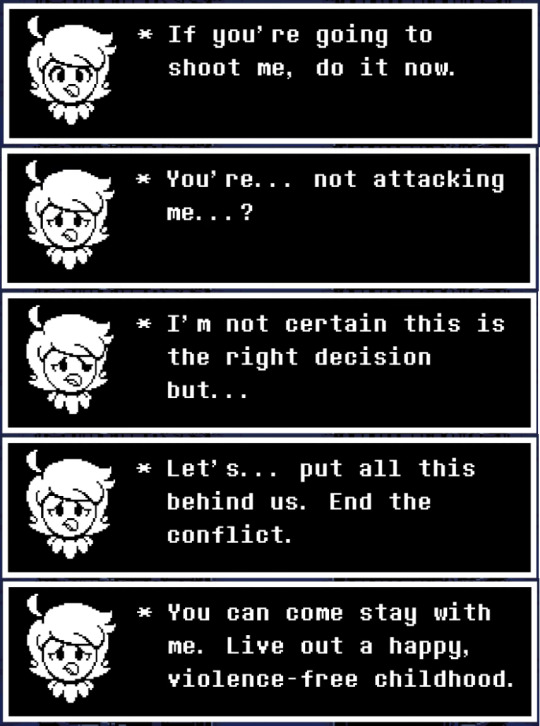
No matter how badly you beat Martlet in Snowdin and how resolute she is at stopping you, she’ll turn on a dime if you’ve aborted a run prior to Oasis or Hotland just so that she can play out her allotted part.
Other times it feels like she’ll show up just so that there’s someone for Clover to talk to and someone to react to what Clover sees. Now, it would be reductive of me to write off Martlet as a mere plot device—she isn’t, and any appearance otherwise is more so a flaw of the narrative than of her as a character.
You’ll notice I haven’t said much about how I feel about Martlet’s personality, her dynamic with other characters, or her overall “vibe” and honestly she’s just… fine? It’s hard for me to say anything because she feels a bit lukewarm to me—she’s not undercooked like Dalv, but she’s not as memorable as many of the other characters either. She says some funny things, but she’s not the funniest. She has some great and heartfelt lines during the pacifist ending, particularly this one:
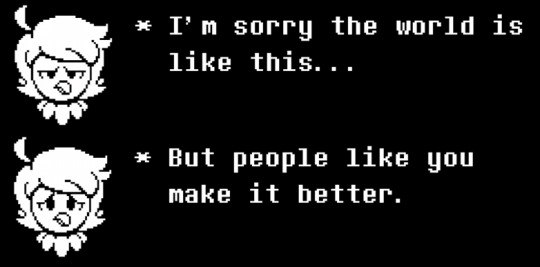
But as a whole? She’s just fine. She's competently written, no major complaints.
I think maybe what Martlet lacks is a “larger than life” quality to her character. I’m not saying that her role within the setting should be larger than life, but rather she could use at least one exaggerated trait to help her stand out from the pack—Papyrus has his bravado, Sans has laziness and jokes, Undyne has intensity, Alphys has awkwardness, and Mettaton has his showmanship. Not every Undertale character is like this, but I feel like Martlet was intended to fit a similar mold—we catch glimpses of it, like her overly long “P.S.” messages amended to her first puzzle, but imo she doesn’t go far enough consistently enough (assuming that was the intent).
One last thing that I want to touch on is Martlet’s contingency plan for Clover that comes into play in the No Mercy run, where she injects herself and becomes “Zenith Martlet,” as fans have dubbed her. Conceptually I’m fine with the idea of Martlet having an ace up her sleeve that she’s too indecisive to actually use in most scenarios.

This feels in-character for her and I can even look past a scatterbrained character with no planning skills having a plan like this since it’s largely Martlet appropriating another character’s plan. The main thing that I find questionable about Martlet’s plan is that it relies on Alphys’ determination extraction experiments.

We the audience know what that is, but how does Martlet know about them or even what to look for? We do know that underground residents were asked to donate fallen down monsters to the lab, but seemingly nothing is revealed to the public about the nature of the experiments. Even Ceroba, who had a vested interest in learning all she could, seems to be completely in the dark. In the pacifist ending, Martlet offers to investigate the experiment for Ceroba, implying she didn’t know the full story either. I also question how Martlet would’ve been able to venture into the true lab seemingly without running into a single amalgamate, given that she never brings them up in pacifist.
Now, my issue here is not the supposed “plothole” that this creates. My main issue is that a more reasonable solution was sitting right there: Chujin’s monster serum. I legitimately wonder if earlier drafts of this game’s story had Martlet using Chujin’s serum instead of Alphys’ extract, because the former would bring everything full-circle and it would tie in more naturally with the flashback scene of Martlet with Chujin.
Now, the obvious answer is that Chujin’s serum was never completed, but I can’t help but wonder if perhaps this wasn’t always the case. During Ceroba’s flashback, we can see a case with two syringes—one full and the other seemingly empty.

This is just my own speculation, but I can’t help but wonder if it was once intended for Ceroba to use one syringe on Kanako and for Martlet to have taken the other. Obviously this doesn’t jive with the story as it’s currently written—Martlet is clearly taken aback when she learns of the experiments that Chujin conducted. Still, part of me wonders if an earlier draft had Chujin entrust Martlet with a prototype of the serum to keep her safe.
I think it’d be fitting if the no mercy route were to reveal that Martlet was a lot more privy to Chujin’s less savory actions than she let on, and that even in pacifist she kept this knowledge to herself of self-preservation or shame. This would fit with a line of hers in the no mercy fight after her flashback of Chujin:

It would be fitting for the NM run if we were to learn that there was always a seed of doubt and mistrust between Martlet and Clover, even during the best of times.
The Feisty Five
I’ll be brief, but when these guys first showed up my first thought was “great, I’ll never remember all these new characters” and I’m glad I was wrong. While they don’t have quite the depth that the main characters do, they’re all memorable in their own way. They’re also the first characters in the game to get a serious chuckle out of me and I wish we got more of them. If we’re comparing quirky miniboss squads, these guys clear the Snowdin canine unit and Sweet Cap’n Cakes. There, I said it.
Starlo
This is the coldest take ever and I won’t even try to bury the lede: Starlo is the best Undertale Yellow character. He’s funny, he’s charming, he’s flawed, he has layers, he has great moments of pathos with Ceroba, and he has a backstory that isn’t tragic yet still feels necessary to his character.
Here’s another cold take: Dunes/Wild East is the best part of the game. Dark Ruins and Snowdin, while not bad, still feel very much like typical fare for a romhack or fangame. Wild East is the first area that truly feels like Undertale, which is ironic since it’s also the first completely-original area.
By extension, Starlo is the one original character who feels most like he could be an Undertale character. It’s easy to take for granted all the little nuances that Toby injects into his characters to make them stand out, which is probably why I felt so lukewarm towards Yellow’s cast up until Starlo’s introduction.
One thing I admire about Undertale’s core cast is that each character has their own unique manner of speaking, to the point where you can identify a character’s dialogue without needing a dialogue portrait or typer sound. Starlo shares this trait, speaking in a semi-stereotypical drawl while occasionally misspelling words (FEISTYJ, dual vs duel). It’s a small touch but it goes a long way to endearing me to the characters in these games.
Although Starlo is mostly a comedic character, he still has plenty of depth. Another hallmark trait of Toby Fox characters is that they have multiple sides to them that seem contradictory at first glance but actually tell you something profound about the character (Papyrus’ bravado masking his loneliness, Sans’ joking to cope with his harsh outlook, Alphys’ awkwardness stemming from her guilt).
Starlo also fits this trend, first presented as a dashing and charismatic lawman that is nothing more than the mask of a nerdy and immature farmboy. And I would say Starlo’s fatal flaw is immaturity—not because of his interests, but because of his attitude. Starlo treats his friends like playthings, takes what he wants from Clover and Martlet when he first meets them, and he acts utterly irresponsible with his (or rather, Blackjack’s) firearms.
We learn from Starlo’s mom that he once pined after Ceroba and that he took a long time to move on.

It’s also implied that Starlo had a grudge against Chujin, which could have been due to the two having differing opinions on human culture or Starlo’s own jealousy over Ceroba.

We can also see this immaturity reach an ugly conclusion if Ceroba is killed in the so-called false or “flawed” pacifist ending. Starlo previously trained Clover to carry the weight of taking a life and also taught them the value of sacrificing one life to save many, but Starlo immediately throws this out the window as soon as Clover acts (as far as he’s aware) in self-defense.
This is a case where I’d argue that Starlo is right but for the wrong reasons. Starlo’s not so much recanting his earlier philosophy as he’s simply upset because someone he cared about was sacrificed this time—had it been a stranger or a ne’er-do-well like Vengeful Virgil then I doubt Starlo would’ve parted ways with Clover so bitterly. That’s just my interpretation, anyway.
None of this is to say that Starlo is always immature. When it comes to his interactions with Ceroba he’s often the most sensitive and emotionally-mature person in the room, which is a trait that we only see grow in him after he gets a reality check in the Wild East. When trying to talk Ceroba down we see Starlo give his respect to Chujin, despite their past differences, and he’s patient and understanding to the utmost once the fight is finally over.


This doesn’t mean that Starlo is a doormat for Ceroba either, as we earlier see him confront her and call her out when he suspects foul play involving Kanako—he clearly cares for Ceroba a lot but won’t sit idly by while she ruins her life or the lives of others.

Honestly, Starlo’s bond with Ceroba is a contender for the most wholesome relationship (platonic or otherwise) in the entire franchise—yes, I’m actually saying that there’s an aspect of this game’s writing that rivals and perhaps even surpasses Undertale and Deltarune.
I realize a lot of my analysis of Yellow’s writing has skewed negative, but as a reminder I am grading this game on a curve because it’s a companion piece to one of the best-written games of all time. To give Yellow a bit more praise, I think it might actually do a better job than Undertale at portraying characters’ moments of vulnerability and allowing them to cut to the emotional core of an issue, as seen with Starlo and Ceroba’s late-game interactions as well as Clover’s ultimate fate and its aftermath.
Unlike Undertale, there was no moment in Yellow that quite made me cry, but moments in the pacifist ending came close. I consider this quite the feat because the final outcome of Yellow’s pacifist ending is easily predicted from the start and the way that it plays out is a concept that would be difficult for any writer to sell. Yellow was backed into a corner by being a prequel, whereas Undertale had free reign to tell whatever story it wanted. In many ways I feel Yellow’s ending did just about the best job it could with the hand that it was dealt—it’s not perfect, and in one or two areas I feel it overplays its hand (which I’ll cover shortly), but the writing succeeds far more than I would’ve thought it would have with such a concept.
Axis
This’ll be another brief entry, but I wanted to include Axis since he always seems to get left out of fanworks. I enjoy Axis but I’m not sure I fully understand him. His overall arc and goals are very straightforward, but for the life of me I can’t really nail down what his personality is. He’s funny and memorable, which goes a long way for me, but I can’t really wax poetic about him beyond saying that he’s your stock quirky robot. It is a bit of a shame that, like Dalv, he’s largely isolated to one area and has little to no interaction with the rest of the cast.
I suppose one thing that bothers me is how robots in this game aren’t treated as people, which feels at odds with the broader themes of Undertale. We’re taught that amalgamates and even a soulless flower are still people, so having robots that lack free will and don’t even count as EXP kinda rubs me the wrong way. I generally don’t like when fictional works treat sentient robots as less than human or “soulless.” In my view, the true point behind sentient robot stories isn’t to debate whether robots have souls, but rather to question what a soul is and who gets to decide who has one and who doesn’t, or whether they exist at all.
Robots in fiction are meant to be a reflection of humans, and the robots in Yellow could have been presented as a reflection of video game characters as a whole—can free will exist when you’re programmed to fulfill a function? Unlike in our world, souls are a scientifically measurable quantity in Undertale’s universe, so I guess Yellow’s portrayal of “soulless” robots works on a technicality, but that doesn’t mean I have to like it.
Ceroba
I don’t think it’s a stretch to say that Ceroba is the most controversial character in the game, and I find my own opinions of her (and her family) to be polarized as well. In a neutral run she’s barely noticeable but in pacifist she eventually becomes the main focus of the story. I’ve seen some people criticize Ceroba’s level of focus, but I’d liken it to Alphys and Flowey’s elevated level of focus in Undertale’s true pacifist ending. In other words, it doesn’t bother me.
Ceroba’s personality is a bit of an anomaly for me in the sense that she’s not quirky like a typical Undertale character, and yet I feel that aspect of her works for the story that Yellow tells. Previously I mentioned how Martlet didn’t really “wow” me as a character in part due to her lacking a sufficiently “larger than life” personality, but I feel Ceroba succeeds where Martlet didn’t for me because (1) Ceroba is clearly not intended to be a comic relief character and (2) Ceroba often acts as the straight man to other characters like Starlo and the Steamworks machines, whereas Martlet often feels like she has no one to work off of her besides Clover (for whatever that’s worth). In many cases, Ceroba’s understated reaction to things or her attempts to parse or explain them rationally end up making scenes funnier, such as when Starlo cuts off her piece on the ethical quandary of his trolley problem.
Having said that, I do think it’s a bit of a missed opportunity that the game doesn’t expand more on Ceroba’s own interests or quirks outside of her family. While showcasing a character’s hobbies can sometimes feel like checking an item off of a list, it helps add a bit of texture to a character that makes them that much more believable.
Not knowing this information doesn’t “ruin” Ceroba or anything, but it’s a bit disappointing that most of her “talk” dialogue in the steamworks, while interesting, pertains to her immediate surroundings or her family and friends instead of herself. The most we get is that she used to have a gym membership and (if I recall) she was once a waitress. We later get to see her room and all that’s in there is a bed, a photo, and her clothes. After seeing all the loving detail put into Papyrus and Alphys’ living areas in Undertale, it’s such a shame to see Ceroba’s opportunity squandered.
Oddly enough, if there’s one existing bit of characterization that I think could’ve been retooled sightly, it’d be Ceroba’s dynamic with Clover. Ceroba is a mother who lost a child around Clover’s age (or younger) but she’s also distrustful of humans and had a husband who hated them. You’d think that Ceroba would react strongly to Clover one way or the other, either distrusting them as a human or having a soft spot for them due to Clover being a child, or feeling conflicted between these two outlooks. Instead Ceroba seems utterly casual around Clover.
Initially her laid back attitude served as a nice contrast to the overbearing wackiness of Starlo and the Feisty Five and helped endear Ceroba to me as a character, but it begins to feel a bit out of place when she says things like "I respect the hell out of you" to a child.
Maybe I’m overthinking it, but the way Ceroba treats Clover makes sense for how she’d treat a stranger who was a monster, given what we see of her personality, but I’m just not sure it makes sense that she’d treat Clover that way specifically. I’d be fine with it if the narrative unpacked the idea—maybe she’s casual around Clover because she’s too world-weary to muster a strong reaction, or maybe she’s forcing herself to act casual to hide her true plans for Clover, or maybe she never fully agreed with Chujin’s rhetoric on humans and is acting against them out of pragmatism, or maybe she never liked kids until she had one of her own, etc.
Speaking of kids, I guess there’s no avoiding the elephant in the room: Ceroba’s backstory. If I had to guess, I’d wager this is probably the most controversial portion of Undertale Yellow’s entire narrative, and I have a lot to say about it.
To start, I’ll say that I really like the way that (most) of Ceroba’s backstory is doled out to the player piece by piece over the course of a playthrough. As early as Snowdin you hear mention of Chujin, then in Wild East you can piece together from various bits of dialogue that Ceroba had a family that she’s reluctant to speak about. Steamworks fleshes out Ceroba and Chujin’s pasts considerably, albeit mostly hidden behind optional talk dialogue.
Steamworks also has one of my favorite scenes in the game when Ceroba learns why Chujin got fired—it technically doesn’t contribute anything major to the main plot, but it helps illustrate Chujin’s flawed methods that Ceroba willfully overlooks so that she can double down on furthering his “legacy.”
Right before Hotland is when the other shoe drops and Starlo confronts Ceroba—this was the moment that had me hooked on uncovering the mystery of Ceroba’s past. This leads right into the abandoned Ketsukane estate, which is another of my favorite sequences in the game. I was always a huge fan of Undertale’s True Lab and Ceroba’s house scratches that itch for me. The two locations have a very different tone and style of gameplay (or lack of), but both are dripping with unsettling atmosphere and environmental storytelling. Maybe it’s just me, but I’ve always been creeped out by abandoned houses—not decrepit haunted mansions per se, but places that were abandoned so recently that you’re not sure whether someone might still be lurking inside.
Unfortunately, I start to run out of nice things to say about this storyline as soon as Clover and Martlet enter the estate’s basement. Before we descend into that chasm, I want to make one thing perfectly clear: I am not a “Cinema Sins” kind of guy. I do not go into a work of fiction looking for inconsistencies to complain about. My philosophy is that I can overlook the occasional plothole or retcon or bending of the rules if it’s done in service to a good story or memorable character moment.
If anything, I find it annoying when a story tries too hard to cover all its bases with exposition out of fear that some smartass is going to find some plot detail to complain about—this just draws more attention to potential “plotholes” that could’ve easily been ignored. I don’t care if the eagles could’ve carried the ring to Mordor and I don’t care whether the ark of the covenant would’ve killed the bad guys in Raiders if Indy wasn’t there. At the end of the day, if a story is well told then I can overlook things like that, and if it’s not well told then my mind wanders and I begin to notice those sorts of things, but those nitpicks (more often than not) are not the underlying cause of the problem—lack of a compelling story or believable characters is.
So, getting back to the basement. Here we see Chujin’s tapes and the plot begins to lose me. Chujin wants to create a serum that will strengthen monsterkind and give normal monsters the power of a boss monster. All well and good. Where I start to take issue is the convoluted method of creating this serum and what it means for the story.
As a point of comparison, I always thought that the rule in Undertale of requiring a human soul plus a monster soul to pass through the barrier felt a little convoluted and contrived, but it seems to exist for the sake of forcing a “kill or be killed” confrontation between Frisk and Asgore as well as explaining why Asriel passed through the barrier with Chara’s soul but (presumably) Chara alone couldn’t. In this way, the rule acts in service to the story and creates memorable character moments with Alphys and Asgore and gives Frisk a stronger temptation to kill Asgore during their fight. The two soul rule is a bit clunky, but I can begrudgingly accept it. Chujin’s serum fulfills a similar purpose but is clumsier in its execution.
To start, Chujin’s serum also requires a human soul and a boss monster soul—this makes sense, as the goal is to turn monsters into boss monsters and one can assume that human souls have some kind of preserving property that would keep the serum stable.
On top of that, the human soul must also be “pure of heart, uncorrupted.” I thought nothing of this line initially until it was reiterated during Ceroba’s flashback and I realized why it was in the story.

This concept bothers me for a number of reasons and it’s technically not even a plothole or inconsistency. It feels out of character for Chujin to frame things this way given how he views all humans as evil, and this purity rule seems to exist solely as a plot device to explain why Ceroba enacts her plan in pacifist but not in neutral runs. I feel like the story could’ve come up with a more organic method of explaining why Ceroba couldn’t be present or was otherwise occupied during the steamworks section in a neutral run, plus I feel like she wouldn’t let something like “purity” get in the way of attempting her plan if she was that dead-set on it, given how rarely humans appear in the Underground.
Lastly, we learn that Chujin and Kanako are both boss monsters, or at least “carry the boss monster gene,” which is an odd concept to me. You could argue that this revelation technically doesn’t contradict anything established in Undertale, but like the pure soul rule it just bugs me. Maybe it’s because it reminds me of the early days when the fandom thought that all bosses in Undertale were boss monsters instead of just the Dreemurr family. I won’t waste time rambling about the particulars of boss monster lore, but I think what bothers me with Chujin and Kanako is that it feels like yet another contrivance to explain why Ceroba’s actions had to involve Kanako specifically.
I’ve mentioned that Undertale’s two soul rule feels somewhat like a contrivance. One could argue that the Barrier requiring seven human souls to shatter is also a contrivance, but I think what makes that easier to swallow is that it’s a rule that’s established fairly early in the game. The reveals of the Barrier’s two “rules” are spaced apart from one another and each are given dramatic weight and time for the player to dwell on their implications.
The mechanics of Chujin’s serum, on the other hand, rely on multiple contrivances that are all spilled out onto the floor at once in the final stretch of the game right before they become necessary to explain Ceroba’s motivations, which only makes their narrative purpose feel all the more transparent.
Getting back to Ceroba, we’re left with her plan and what she did to Kanako. Now, I’m going to give the benefit of the doubt here and say that I don’t mind the particulars of whether Ceroba’s plan involving Clover would have worked or not—as far as I’m concerned, Chujin’s plans could have been doomed from the start even with a “pure” soul. The point wasn’t whether Chujin’s plan would’ve worked but rather how Ceroba’s grief has turned her own life (and by extension the lives of her family) into a sunk cost—she feels that she has to go through with her plan or else all her family’s suffering was for nothing.
In many ways this makes the contrived requirements for Chujin’s serum feel less necessary, since the serum’s mechanics could’ve been kept vague or it could’ve even been implied that Ceroba was simply repeating the same experiments as before hoping for different results.
I’ve put it off long enough, but it’s time to talk about that scene. You know the one: the big reveal flashback at the climax of Ceroba’s pacifist fight. Again, I’ll try to be charitable and say that I don’t absolutely hate the idea of Ceroba testing Chujin’s serum on Kanako. I mean, I would hate the act on a moral level if she were a real person, but I don’t hate the idea as a story concept. Still, my charity has its limits.
I’ll just come right out and say it: the scene where Ceroba injects Kanako is hard to watch—not because it’s tragic, but because it’s just not a good scene. My original write-up for this part was far harsher, but I’ll spare the vitriol. This scene has been memed to hell and back by people more critical of the game and… I can’t disagree with them—this is my least-favorite scene in the game.

(Image from ScottFalco's "Undertale Yellow with a side of salt" video)
The most obvious criticism I’ve seen is the fact that Chujin specifically told Ceroba not to do the exact thing that she does. That’s a fair point and honestly, yeah, I think the simplest writing fix would’ve been for that line not to have been in Chujin’s tape to begin with so that Ceroba doesn’t look willfully ignorant on top of being recklessly negligent.
Tbh, it feels a little out of character for Chujin to say something like that because I got the impression that Chujin wasn’t always the most thoughtful or attentive dad. His own tapes mention that he didn’t keep an eye on Kanako when a monster was attacked in Snowdin, and even then Chujin was more preoccupied with tracking down the human than with comforting his own daughter. He made nice things for Kanako, sure, but even that could be explained as him being more wrapped up in the work than her. It’d be wrong to say that he didn’t care about Kanako at all, but I got the impression that he had the wrong priorities and it’d be fitting if Ceroba’s own actions followed that pattern.
That being said, I can’t solely blame Chujin’s warning for why Ceroba’s flashback doesn’t work. The scene as a whole is just dreadful, even when viewed in isolation from the rest of the narrative. There’s so many issues big and small with this scene, like Kanako being able to read the word “corruption” but not “extract,” Ceroba’s immediate turnaround after the slightest prodding, or the predictable outcome of the whole thing that’s dragged out for what feels like an eternity.
You know, I’ve heard some people critical of Undertale say that the true pacifist ending to that game felt maudlin—I disagree, but in some places I could see where they were coming from. Calling the Kanako flashback maudlin would honestly feel like letting it off easy. If I wanted to be mean I’d call it manipulative, but honestly I think a more fitting term would be a comedy of errors. It feels less like tragedy and more like dark humor bordering on self-parody of what an Undertale character’s sad backstory would be.
So what should’ve been done differently? The easy and safer option I’ve seen suggested would be for Kanako to stumble across Chujin’s research and inject herself, with Ceroba feeling guilt for allowing it to happen. I would prefer this over what we got, but I said earlier that I don’t completely hate the concept of Ceroba experimenting on Kanako, so how can that idea possibly work? Besides getting rid of Chujin’s overly-specific warning, I honestly think the best fix for this scene would simply be to not show it. Don’t remove the events from the backstory, but just don’t reenact them onscreen. Normally it’s better to show than tell, but there have always been exceptions to that rule.
I’m reminded of how Undertale didn’t show us Asriel’s death or the Dreemurrs’ divorce, and only offered a glimpse of Chara’s buttercup plan. These were cases where less was more—letting the players imagine these events in their heads sidestepped any potential tastelessness and seeing the aftermath of these events and how they affected the characters involved painted a vivid enough picture. I think Ceroba would be a perfect fit for a similar approach.
If we need to see something, then either portray it via montage like Asriel’s memories or only portray Kanako finding Chujin’s basement and Ceroba stumbling upon her after she’s viewed the tapes. Ceroba could then explain to Clover that Kanako pleaded with her for months or even years to let her help with Chujin’s experiments. With time Kanako only become more stubborn and their relationship more strained. The whole time Ceroba knew that only Kanako’s soul would work for the experiment but she tried to remain in denial and hope an alternative would present itself. After countless research dead-ends used up all but one vial of the leftover human soul extract, Ceroba gave in to Kanako’s demands in a moment of weakness. And that’s all it took—one moment she was there and the next she was gone.
Not to toot my own horn, but I feel this kind of summary would’ve worked better because it leaves things up to interpretation. Was Kanako still a child when this happened or was it many years later? Did Kanako understand what she was signing up for? Is Ceroba’s recounting of the events reliable or is she merely rationalizing her actions after the fact? It’s not perfect and it’s still somewhat “safe” compared to the game’s swing for the fences. Unfortunately, a big swing means nothing if it misses, and even less if the bat goes flying and hits someone.
Despite what I just said, the Kanako scene doesn’t ruin Ceroba for me as a character. It blemishes her boss fight for me, though I have other issues with that fight besides the flashback (as I’ve mentioned). When thinking back on this game’s characters and story, I mostly just ignore the particulars of the Kanako scene unless if I need to sit through it again. I view it as the equivalent of a flubbed line read or a boom mic visible in a shot--I can see the pieces that were meant to be there underneath the lackluster execution.
Surprisingly, Ceroba’s still my 2nd favorite original character in Yellow, though a lot of this is owed to her dynamic with Star, and part of me wonders if I like her more for the character she could’ve been rather than the character we got. Still, I’ll always remember the buildup to the mystery of Ceroba’s backstory, even if the reveal failed to deliver.
Flowey
Flowey is one of my favorite Undertale characters as well as the only character from Undertale featured in a recurring lead role in Yellow, so I was curious to see how this game would handle him.
When this game was first announced, many fans debated the “canonicity” of whether Flowey would have encountered the human who fell prior to Frisk and whether Flowey would retain his save abilities in such a scenario. Often this debate overshadowed the other aspects of Flowey’s portrayal, so to avoid doing the same, I’ll just say that I don’t believe Toby ever intended for Flowey’s save abilities to function in relation to a human like how they’re portrayed in Undertale Yellow. However, I don’t take issue with this “lore contradiction” because I feel that the way Flowey is utilized in this aspect works for the story that Yellow is trying to tell. Flowey’s role is to limit Clover’s own powers and to keep their story on-track.
It’s easier to tell a prequel story where the main character is destined to die if that character doesn’t also have the ability to return from the dead at will or turn back time, so having Flowey fill that power vacuum makes sense. Despite this, Clover is still given plenty of agency. Flowey only railroads their story in two notable instances: whenever Clover is going to live with Toriel or when Martlet offers to have Clover come live with her in a neutral run. Both outcomes would be a bit of a cop-out for the game’s main conflict and would be the boring option as well (sorry fanfic authors)—Flowey agrees with this sentiment, making it feel justified that he’d intervene.
Having gotten that out of the way, what do I think of Flowey’s portrayal? Compared to Undertale, it’s interesting to think how much more screentime Flowey receives in Undertale Yellow, despite Flowey being the main antagonist and ostensible central character of Undertale. Since Flowey’s story can’t be allowed to conclude in Yellow, his character is kept in some degree of stasis—in many ways, Yellow’s portrayal can be seen as “Flowey, but more.” That might sound like a pejorative, but for the most part I think it works here. Flowey’s interactions with Clover honestly make him feel a little underutilized in Undertale by comparison.
That said, Undertale was a game intended to have moments of isolation, so having Flowey chime in at every save point likely would have diminished that effect and also made Flowey less threatening due to overexposure. I think Yellow can get away with giving more screentime to Flowey because for most of the game his mask hasn’t dropped—he has every bit of ill intent that he did in Undertale, but for the sake of his plans he has to play along at being your friend for far longer than he did in Undertale.
The result is that very little of what Flowey says in Yellow can be taken at face value once you know his aims. Until that point, however, I think the game does a good enough job at keeping you guessing as to how far gone Flowey is and at what point in his moral decline this story is meant to take place. If someone played this game without playing Undertale first, they’d probably chalk up Flowey’s mannerisms to him just having an odd and occasionally morbid sense of humor, which isn’t far from the truth.
One thing that I appreciate about Yellow’s portrayal of Flowey is his dynamic with Clover—the game manages to thread the needle of not making their relationship an also-ran of Flowey and Frisk or Flowey and “Chara” from Undertale’s No Mercy run. For most of the game you get the sense that Flowey views Clover as a means to an end that he’s forced to humor and put up with, but that deep down he likely has some small sentimentality towards them (mainly shown in the pacifist ending).
I think Flowey’s relationship with Clover in neutral and pacifist gives us a look into how he likely acted around the other monsters of the underground back when he tried to solve their problems or form bonds with them—he can’t fully relate to them but is willing to fake it ‘til he makes it, or rather until they make it to the outcome that he wants. If I were to draw a more direct comparison, I think Flowey’s bond with Clover might be the most similar to his bond with Papyrus—he’s implied to have spent a lot of time with each of them and found them each amusing in their own regard, but ultimately Flowey isn’t above using them or casting them aside.
What I find especially compelling about Flowey and Clover is the turn that their partnership takes in Yellow’s No Mercy route. Here Flowey initially seems to be cautiously optimistic about Clover’s rampage, but as his advice is ignored he grows increasingly exasperated with their actions. It’s strange to say, but it’s a refreshing dynamic to see Flowey outright grow to hate his human companion—while he voiced plenty of insults and disdain towards Frisk, it came off more as condescension or an attempt at intimidation.
In Yellow, however, you can really feel Flowey becomng absolutely fed up with Clover, not just for their pushiness and disobedience in the no mercy route but also for the hundreds of runs where Flowey has had to string them along and, in the process, be strung along himself. This development is much better-paced in Yellow than Flowey’s turn toward fearing Chara in Undertale—it’s amazing what can be done when you’re allowed to have more than four conversations with a character.
That said, I don’t think there’s any one Flowey moment in Yellow that quite lives up to Flowey’s speech in New Home or the conclusion to his story in the form of Asriel—those two moments will forever be peak Flowey to me. When comparing Undertale Flowey to Yellow Flowey, it’s a case of quantity vs quality, but in this case the “quantity” is still pretty good.
If I had to voice any complaints for Yellow Flowey beyond a broad “it’s not as good as something near-perfect”, I will say that when Flowey’s mask does drop in Yellow, he doesn’t sound quite as crass or childish as he does in Undertale—something I feel is important to him as a villain, but this is a very minor nitpick since he has plenty of lines in this game that go hard. I didn’t even notice the difference in speech styles until I went back and watched footage of Undertale and realized “oh yeah, I guess he sounds a bit more childish here.”
I suppose there’s one other thing I should discuss regarding Flowey. This is a topic that I intentionally saved for last since I find it’s a perfect capstone for Undertale Yellow and my opinions on it: Flowey’s boss fight. If ever there was a case of “Flowey, but more,” it would be this fight. For years Undertale fans have speculated and wished and wondered what a fight against plain old vanilla Flowey would be like. Countless fangames and fan battles have tried.
Yellow opts for an unorthodox approach by centering the entire fight within Flowey’s mind—this framing is used to its fullest and then some, allowing for interface-screws and psychedelic attack patterns showcasing Flowey’s twistedness, his self-loathing, and his various forms of retraumatization.
Players are attacked by phantoms of any bosses that they killed, complete with Floweytale-esque corrupted designs. This aspect of the fight dovetails perfectly with Flowey’s comment about only enjoying the moments of Clover’s run where they “gave in” to their violent urges, and clearly these moments are etched in Flowey’s memories for Clover to relive.

Afterwards we’re treated to a peek behind the curtain at Flowey’s subconscious, featuring a collage of his first runs as a flower—this whole sequence adapts my favorite Flowey moment from Undertale while not tipping its hand too much by revealing Flowey’s true identity, as it easily could have in less-skilled hands. We’re given just enough to ponder without spoiling things for the mythical gamer who tries playing Yellow before Undertale.
Next up is a brief horror fakeout where Clover “reunites” with Martlet. I don’t have much to add other than the telegraphing being a bit obvious but not in a way that majorly detracts from the moment. Overall it just makes me consider that this fight as a whole might be scarier than anything in Undertale
Finally we have the climax of the fight. I’m not quite sure what to call it. Photoshop Flowey 2.0? To be brief, the visual spectacle shown in this phase surpasses not only the visuals of any sequence (so far) in Undertale or Deltarune, but I think it’s unlikely that future chapters of Deltarune will feature anything with visual flare on the level of this finale.
That’s probably the highest praise I’ve given to Undertale Yellow so far, which is what makes this next part so difficult. I’m sure this will go down as my hottest take in this entire review, and it breaks my heart to say it given the clear effort on display from the developers, but…

I did not care for the Flowey fight.
How can I even say that? Was all of my prior praise just a lie? Not at all—I meant every word of it and then some. So how is it possible that I didn’t like this fight? You’ll notice that I broke down the Flowey fight into its individual phases and aspects, praising each in isolation. You might also notice that my praise was aimed at the spectacle and underlying concepts of the fight, which are fantastic, but I had very little to say about the actual experience of playing the fight—and that’s because I found the fight to be an utter slog to get through. In hindsight, it might actually be my least-favorite fight in the entire Undertale franchise if we’re solely talking about the gameplay. I’d rather fight a Jerry than have to fight this thing again.
I’ll admit up front that I sucked at this fight when I played it. I sucked at all of Yellow’s final bosses and initially didn’t care for their gameplay. I eventually warmed up to Ceroba and Martlet’s fights as I got better and learned to beat them without needing easy mode, but the Flowey fight never clicked for me in the same way despite arguably being the easiest of the three.
So what’s the problem? There are little things here and there—I found some of the phase 1 attacks a bit obnoxious to dodge, though nothing major. I found the collision detection in the vine chase sequences to be a bit clunky, resulting in one or two deaths that felt unearned, but none of these issues are enough to sink the fight.
No, two major missteps that come to my mind are length and repetition.
Out of curiosity, after my neutral run I looked up gameplay videos of the Yellow Flowey fight and the Omega Flowey fight from Undertale: on average, Yellow’s fight took players twice as long to complete as the Omega Flowey fight. The difference is so stark that a “no hit” speedrun of Yellow’s fight with dialogue skipped, the intro cutscene edited out, and no attacks from killed bosses is still longer than an Omega fight played normally.
I want to be clear that my criticism here is not “it’s different from the Omega fight, therefore it’s bad.” The Omega Flowey fight, in my opinion, already drags at times, and it’s probably my least-favorite final boss in Undertale despite having the most effort put into it. I already take (minor) issue with the Omega Flowey fight for overstaying its welcome, but Yellow’s fight is beyond the pale. One nice thing I can say is that Yellow’s fight at least tries to break itself up with an intermission of sorts in the middle, but the whole experience is still technically one fight, so in some ways this just feels like padding, particularly the Martlet scene.
To give a non-Undertale point of comparison, the Flowey fight reminded me (oddly enough) of Darth Vader’s hallway fight scene in the film Rogue One. For many fans this scene was considered the highlight of the entire film, but a vocal minority at the time criticized this scene for being irrelevant to the film’s central characters and unnecessary to the overall plot—it was just something thrown in for fan service that could have been cut at no detriment to the overall narrative. While I can understand the latter perspective, I have no issues with the Vader scene at all—if anything I think it enhances the third act’s feeling of desperation. but overall it’s just a cool scene and that alone makes its inclusion feel warranted.
So why do I feel different about Vader’s scene compared to Flowey’s fight? After all, both are action-heavy “scenes” featuring the main villain of the original installment doing what they do best at the end of a prequel that wasn’t centered on them. The difference is that Vader’s scene is less than 2 minutes long. It’s closer to 60-90 seconds if we only count the portion where he’s onscreen and it’s less than 1% of the film’s runtime. Conversely, there’s a no commentary neutral run of Undertale Yellow on Youtube where the Flowey fight takes up about 15% of the overall run. Had Vader’s scene been that long, even if it were expertly shot and choreographed while being broken up with bits of pathos, I would’ve been checking my watch and waiting for it to be over.
Still, I could forgive the Flowey fight’s length if it had variety and was building toward something. Surely this is true of the Yellow fight, right? Well, I would say that the Yellow Flowey fight probably has the widest variety of total attacks in the game—it has six unique photoshop phases as well as copied attacks from previous bosses in the first phase. The problem is that these are part of his total attacks but not necessarily his most common attacks—half of the ones I just listed are optional depending on who you killed and the other half are for brief one-off phases.
For the majority of the fight you’ll be dealing with Flowey’s other attacks: his standard attacks, which are recycled ad nauseam with little variation and no iteration. In phase 1 this isn’t too noticeable if you only killed one or two bosses, but if you killed most (like I did) then every unique boss attack is sandwiched between a standard Flowey attack and a vine chase sequence, which really bloats the runtime of the fight. Still, I’d argue that phase 2 is the worse culprit in this regard.
For those who’ve played, let me know if this sounds familiar to you: four vines shoot up out of the floor, four piranha plants emerge twice spitting up bullets, two hands scroll across the screen lazily scattering pellets, three guns materialize and fire at your location, a bomb with an “X” or “+” shape detonates, a small circle with spikes orbiting it homes in on your position, and two cowboys riding horses gallop by until one explodes, all while the song “Afterlife” plays from the beginning. Now tell me: which part of the fight am I referring to? If you guessed “more than half of all attacks in the 2nd phase,” then you’d be right!
Now, some of you might be questioning why I’m complaining about lack of “variety” when I just listed off seven individual attacks and earlier I complained about Yellow bosses using too many types of attacks. Well, the problem is that these same seven attacks are all used in sequence with each other over and over and over with no progression—each phase of this lasts 25-30 seconds and it’s repeated at least 7 times in the fight (more if you die).
Combined, no joke, this one sequence of attacks lasts 3 minutes, longer than an entire pacifist Toriel fight (dialogue included). Don’t believe me? Look it up on Youtube. You spend at least 10% of the Flowey fight dodging this one attack pattern. You literally spend an entire Toriel fight dodging just one prolonged attack pattern. And as the cherry on top, “Afterlife” always starts over from the beginning each time this sequence plays—just to drill into your head how repetitive this all is.
To be fair, Omega Flowey has a similar problem of repeating a ~25 second attack phase multiple times, but I find it more bearable there because:
Omega Flowey randomly uses 3-4 types of attacks from his larger arsenal per phase instead of trying to cram nearly every single one in every time like in Yellow, which (ironically) makes the Omega sequences feel less samey
Omega Flowey makes use of loading, which spices up the encounters by feeling unfair initially until you notice the save messages in the corner that telegraph them
Each of Omega’s sequences has a Fight button that, though optional, acts as a goal and motivator, as opposed to the player just impotently killing time until the phase ends, and
Omega Flowey’s music doesn’t start over from the beginning each time he attacks.
Those last two might seem minor since they don’t directly affect the overall gameplay, but I honestly think they’re the most crucial because they give the player a goal and a feeling of progression, even if it’s illusory.
Probably my biggest issue with Yellow’s Flowey fight, even more so than the length and the repetition, is that it ultimately doesn’t go anywhere. It pretty much can’t be allowed to go anywhere due to the aforementioned “stasis” of Flowey’s character arc. Flowey can’t suffer a grand defeat or learn a lesson that impacts his character in any major way, which only makes me question why this fight is here at all.
Omega Flowey, while feeling hopeless and repetitive in some places, has a clear progression, goal, and conclusion that leads to Frisk either reinforcing Flowey’s beliefs or causing Flowey to seemingly question them and offer a path to the true pacifist ending. There’s a reason why the song “Finale” is considered an underrated gem—because it shows a clear turning point and building momentum in that fight. I’m not saying Yellow’s fight needed to copy this same moment, but instead it just peters out with nothing to show for itself. I mean, do I even need to say anything when the game itself basically makes my case for me?

So what would have been better? Personally, I think the first phase of the fight is largely fine as-is. Phase 1 is by no means without its flaws, but it’s the phase that’s most relevant to Clover and the overall story on a thematic level—the boss attacks are a consequence of Clover’s actions and the vine chases (though repetitive) are meant to symbolize Clover’s endlessly repeated runs. And the thing is? The pieces are already there for the fight to end in a more natural way that respects the player’s time.
If the fight were to be given a page 1 rewrite, then I would end it at the section with Flowey’s subconscious that shows his past. Why?
It’s a great scene on its own that should be kept,
The scene would actually be relevant to the fight instead of it going unremarked on like it currently is (seriously, Flowey has nothing to say about it?),
It would fit the central conceit of the fight—Flowey is able to peer into Clover’s memories but Clover can do the same to Flowey and that scares him, and as a result...
It would be a more believable and character-driven “off ramp” for Flowey to back out of the fight.
This last point is especially important because we see throughout Undertale Yellow that Flowey is constantly hiding from other monsters—he clearly doesn’t want to entangle himself with them or have them interfere in his affairs. We can also pick up from his dialogue in Undertale and, to a lesser degree, Yellow that Flowey doesn’t want to talk about his past life as Asriel.
Having Clover intrude upon that territory would likely spur a strong reaction from Flowey, to the point where he’d rather abandon his plans, albeit temporarily, than open up that side of himself to a stranger. This would not only make the fight shorter and end it on a more emotionally resonant note, but I feel it also makes more sense for the narrative and themes of Yellow.
Flowey’s rationalization for letting Clover go could be something to the effect of needing to “tidy up” his head space before he’s ready to share it with someone else. Perhaps in the process he could drop a hint that he’s only opened himself up like this once before (with Chara) or that he had thought he had buried those old memories for good.
I also feel like this explanation would work better in the greater context of Flowey’s actions—Flowey quitting the fight out of boredom raises the question of why he’d repeat the fight on future neutral runs or why he’d be so confident that he could absorb the six souls in Undertale if one was too stubborn for him. Instead, having Flowey be emotionally unprepared for his plan but trying to find a workaround would lend itself better to him trying again in the future—to him it was just a little slip-up that he can overcome with enough attempts.
I don’t want to give the impression that my critique here is “the Flowey fight wasn’t done the way I’d have done it, therefore it’s bad.” My suggested “rewrite” to the fight is merely piggybacking off of what was already there, which are great concepts that I could never have dreamed up myself. The problem is that there’s just too much. Way too much. It feels like not enough was cut during the planning stage and what we’re left with is the epitome of “less than the sum of its parts.”
Of course, my rewrite omits the 2nd phase entirely—something that couldn’t be done with the current fight since it’s the most visually stunning segment of the entire game—like it or not, that genie is out of the bottle.
If I had to give any suggestions to improve the fight that we currently have? I’d say that I don’t think the “afterlife” portions of the 2nd phase need to be repeated so often. I think the phase would be better paced if afterlife only occurred at the very beginning and very end, and instead each mini-phase just brought you right back to Flowey’s petal roulette wheel to take you into the next mini-phase.
None of this is to say that I hated the Flowey fight overall. I still love many of the concepts that the fight brings to the table and I’ll watch moments of it on Youtube from time to time, but I just don’t care to experience it again firsthand any time soon, which is pretty much the opposite of how I felt with the Omega Flowey fight.
Looking at Yellow’s final bosses now that I’ve completed them all, I think my favorite might actually be Zenith Martlet? Which is insane to me because I hated that fight the first time I tried it—anyone who shared a Discord with me can attest that I was complaining nonstop when I attempted that fight.
Even now I’d say the Zenith fight is sloppy and the bandaid solutions for it in the 1.1 patch only illustrate how unbalanced this fight originally was. I’ve never beaten it on 1.0, nor do I intend to, yet in 1.1 I’d say I probably enjoyed myself the most with this fight. It doesn’t overstay its welcome like Flowey, nor does it have anything as egregious as the Kanako cutscene in the Ceroba fight. It respects my time, it has great music (though that’s par for all the bosses), the attacks (while chaotic) mostly stick to a consistent handful of themes, and the narrative context of the fight works (minus the bit with Alphys’ lab).
At first I found the Zenith fight unfitting for Martlet as a character. I thought “what? Martlet isn’t some hidden badass,” but that was exactly the point—this isn’t who Martlet is, and reality catches up with her. The 2nd phase is my favorite part of the fight as we see, in typical Martlet fashion, she didn’t plan ahead and can only hopelessly flail about as the “enemy retreating” motif overtakes her theme. It’s a somewhat understated and undignified ending to the character and that’s exactly what makes it work—it’s another example of the game showing restraint and being all the better for it, as opposed to overreaching.
That said, if I wanted to cheat, I’d say my real favorite final boss is the Asgore “fight” from the false pacifist ending. It’s focused on the characters and their goals and it doesn’t try to be anything too flashy. It’s an even more understated yet fitting final boss than Martlet, though the rest of the “false” ending outside of Asgore is a bit lackluster since it’s just a glorified neutral ending.
Conclusion
To wrap things up, I’m sure you’ve all noticed the throughline here: Undertale Yellow is at its best when it’s tasteful and restrained, and at its worst when its ambitions run wild. Of course, that’s easy for me to say from the outside looking in. It’s likely that many of the things I enjoyed about Yellow were ambitious in their conception but were handled carefully enough to appear restrained and effortless. I have no intention of downplaying that—the project as a whole was ambitious, given the time and effort lovingly poured into it.
As I mentioned in the beginning, my criticisms are not intended to dissuade anyone from trying this game. I would not want this game to be forgotten, but I also would not want it to be uncritically praised as some flawless masterpiece that eclipses the original game—that not only does a disservice to the people who worked on Undertale but also to the people who worked on Undertale Yellow. Both games were carefully crafted and both games have their triumphs as well as their flaws.
The last thing that I would want any fan creator to take way from Undertale Yellow OR the original game would be “this was perfect, just copy what they did.” What’s important is understanding why things worked and where they could be improved. Despite Undertale Yellow’s reverence for Undertale, it takes risks and finds places to innovate over the original game. Not all of it works, but I can respect the effort.
And that sums up my overall opinion of the game—it’s a game that I like but a game that I respect even more. The best complement that I can give is that even the parts of the game I didn’t like still had good ideas evident within them. The pieces were there.
With some tweaks, fine-tuning, and the courage to reign in a couple aspects, I honestly think this game could be made to rival the original one day. But even if that day never comes, Undertale Yellow is still a fine game as-is. It’s not a game I consider “canon” like some fans have argued, but I still plan to replay it alongside the original in the future, and I can’t think of higher praise to give than that.
116 notes
·
View notes
Note
Hello Mr. Dapper! Love this blog and your many reimaginings of classic dnd deities and creatures. I was curious about something: Considering your dislike of purely evil gods and DnDs future focusing on the guy, what are your thoughts on Vecna?

Deity: Vecna, the Whispered One
My task of overhauling d&d’s villanous pantheon was started by a simple critique: that if god was evil, there still needed to be a reason for people to worship it. To go with one example, So many of the death gods in d&d want to kill everything that lives, yet they’re still presented as having legions of followers who are happy to die for them in opposition to the party. You can say “Oh they’re just brainwashed, crazy cultists” but that’s just bad writing and thematically empty, neither of which I want for the sort of games I run.
Vecna is actually an interesting case study in that he’s an outwardly wicked deity that has a theme which people would actively want to follow: As a god of secrets, Vecna is the patron of any who will sacrifice anything to learn the answer to their problems, or conversely, the ones desperate to ensure their own secrets will never be known. The story of Vecna as a mortal mage who attained first lichdom, then godhood is an aspirational one for all those power mad occultists out there, a common enough demographic in the d&d world both as villains and as player characters.
Cults of Vecna worshippers likewise make sense as the whole point behind the historical practice of mystery cults was that those at the upper levels maintained their power through control of information and access to secret learnings. You want to learn how to do magic? To speak to the dead? To protect your secrets from being known? Put on this ominous robe, learn the secret handshake, and don’t forget to drop your tithe intto the altar’s collection skull. Think of it like a forbidden knowledge based MLM.
Here’s some adventure hooks:
While many of the whispered one’s acolytes dedicate themselves to discovering to the delving of arcane mysteries, others focus their attention on more worldly secrets. A powerful noblewoman is being blackmailed by a worshipper of Vecna not only for personal enrichment but also as an act of devotion, after he uncovered proof of indiscretions that would ruin her reputation. While she’s too afraid to go for help herself and risk exposure, a devoted servant has seen her hidden suffering and has contacted the party for aid.
Barely disguising its fiendish nature, a devil in service to Vecna approaches the party with an offer to reveal the secret intents or weaknesses of their enemies, if only they will deign to meet its terrible price. While this information could do great good, or even save lives, just how low are the heroes willing to stoop?
Seeking out the aid of a powerful mage, the party discover the old man on the brink of nervous collapse, having looked to deeply into the void and filled his mind with visions best left unmentioned. Haunted by nightmares both real and imagined, he needs their help in quieting his mind through the gathering of rare ingredients and the distillation of a potent elixir. The process is not without risk however, are the party willing to help if it means erasing the information they need from his head, to say nothing of potentially lobotomizing the poor wizard?
Art
#deity#vecna#divinity: knowledge#divinity: death#divinity: magic#divinity: madness#spy#fiend#lich#cultists
124 notes
·
View notes
Note
chief whats the appeal of withnail and i... i kinda thought it sucked ://
THAT'S OKAY.... you don't have to like it..Each To Their Own.... ❤️ and i do think withnail & i is a very specific acquired taste. if the comedy isn't your kind of comedy or it just doesn't resonate that's fine lol. (and ik some people find the 'predatory gay man' trope in uncle monty's character a bit too much which is fine lol.)
i don't wanna try to change your mind about it because it's totally fine if you don't like it but also i would quite like to ramble about why i like it for 200 paragraphs if that's okay.
i do think withnail & i is something you probably have to watch at the right time, like mentally. like i first watched it when i was bored unemployed stagnating rotting in my small town flop era and so naturally it Resonated. i was literally drifting into the arena of the unwell. making an enemy of my own future etc. and it made me feel worse. it truly is a feel-bad film basically. but i don't mean that as a criticism i mean that's part of its appeal.
also i guess just that type of comedy appeals to me. i like nasty putrid absurd stupid but intelligently written black comedies. and i think richard e and the eighth doctor are very good in this film. like partly it is just a classic quotable comedy to me. and that's a subjective thing obviously. one man's cult classic is another man's it sucked. i learned recently that richard e was and is a teetotal which is pretty awesome considering how grotesquely high and unhealthy he managed to look.
obviously i can't neglect to mention the doomed yaoi though. that's certainly part of its appeal epecially on tumblr the doomed yaoi website. but it's like an absolutely wretched putrid ugly tobacco stained disgusting fried egg flavour of doomed yaoi. which is quite refreshing in my opinion.
but also just the character of withnail is so good. like he's insane and terrible but also extremely sad and someone to be sympathised with. i rewatched the film recently (lol) and what got me was how like. gracious he is about marwood's success. like the main tragedy of the film is marwood finally managing to break out of their mutually assured self destructive mess of bad habits but to do that he has to leave withnail behind. and it's heartbreaking to see withnail get left behind etc. but it's the way withnail for all his ranting and raving never like. openly begrudges marwood for his success like he always puts on a brave face and congratulates him, despite all the despair and bitterness he obviously feels internally. and he tries to "make time" drink driving back to london so marwood can make it back quickly for his audition and it's like </3 .especially because like. in the film we don't even know if marwood is Good at acting. at the end of the film when withnail does his hamlet speech it's like ohhh. he wasn't just a self-important dreamer with delusions of grandeur he can actually act. but it's marwood who gets the luck. and there's nothing really to suggest that he's a better actor than withnail or "deserves" it more. just a simple case of some people make it some don't. some escape the cycle some just stay and rot. idk man.
plus the fact that the film is partly autobiographical/partly based on someone bruce robinson knew? like it's coming from the heart basically.
also i think it is pretty well-shot/good looking as a film? i love the scenes in the countryside, withnail standing on the rock shouting into the misty void etc but also the beautifully pungent and detailed interiors of their flat.
(also, people say that withnail & i is a very specifically british film so i guess that's probably why it works for some and not others. both in terms of the humour and in terms of the subject matter i.e. the end of an era 60s was shit the 70s will be shitter everything's incredibly shit vibe. plus the specifics of monty and the dying breed of upper class twit he represents i guess and withnail's specific brand of oxford educated repressed homosexualism or what the fuck ever.)
idk it's hard to articulate exactly what the appeal of the film is and why i've watched it like 4 times but basically it's just funny and tragic in a way that i Get. joker voice you had to be there you wouldn't get it etc. if the ending theme with withnail walking off in the rain accompanied by his insanely sad clown music doesn't get to you then that's fine, i guess it's just not the movie for you. but me personally i <3 it :)
#i don't feel like ive explained this very well but yeah basically i like it a lot.#and i think about it quite often.#MONTY YOU TERRIBLE CUNT! popping into my head just when i least expect it.#also omg i love that you called me chief. does a silly salute to show how cool i am
11 notes
·
View notes
Text
I feel like trigun maximum just hit that perfect sweet spot of bad DID representation done right. like yes the classic small system, blackout split, with one of them being the stereotypical crazy murderer but there's more to trimax before and after their introduction thats so important. they took all of the DID villain movie tropes, put them in a dying word + a murder cult, and shouted the same thing they've been shouting at everyone for the past 80 chapters: THEY'RE STILL HUMAN, THEY DESERVE A FUTURE!! the same volume they introduce him in is the same volume they get thrown on their redemption arc, because it wasn't DID that was his problem it was their abuser and the thing he made them do. trimax just hits you over the head with all the themes with one character and they're well written and well loved in the rest of the series. they get a cowboy hat and they both purse the cowboy way! the main take away wasn't that razlo needs to be put in a cage, it was hey this protector is trying his best, he has his own emotions, be kind to him. it was really refreshing to see in media and I didn't expect it to come from this.
im afraid that trigun stampede is going to miss the mark. not in a sense that I think they're going to change the ending, but how the story is building up is different. we haven't been shown several instances of the average joe having to kill for personal gain to survive on no man's land, so it makes livio and razlo feel like an individual crazed threat looming over the horizon. it also leans into the horror of episode 6 and 7 and ends up having a demonizing way of depicting disassociation. when wolfwood is in the cell pleading for him and livios just standing there with his eye mysteriously glowing, it gives me the ick. not that there can't be a narrative where both livios and wolfwoods feelings are being recognized in a meaningful way, its more that there's too much time given to ruminate in wolfwoods pov, that the audience is going to see them as threatening longer duration. manga readers know whats coming but a majority of viewers do not. [I did absolutely enjoyed wolfwood pulling him out of disassociation with smell the smell of smoke and calmly saying wake up old friend, it melted my heart. I also thought it was funny when livio shot himself but thats just me and a whole other tangent lmao]
do I think this is going to be better when the series is finished and everyone has all of the pieces? yes, absolutely. its just that the years inbetween their redemption undos what made trimaxs good
TLDR: trimax makes you feel like a fucking idiot for even doubting for a chapter that they were going to stray from their core theme of "everyone deserves a future" just because these guys are a DID system with blood on their hands. meanwhile tristamp finds its faults in the time it takes to get livio and razlo to their redemption arcs because it paints them to be a looming threat more than 2 dudes in a lot of pain.
other systems in the trigun fandom please tell me your thoughts + we should be friends
#but thats just an opinion a systems opinion thanks for watching#we love our wonderful little cowboy tristamp if i catch you doing em dirty we're gonna have even more issues#trigun#livio the double fang#razlo the tri punisher of death#love your protectors everybody#im number 1 let studio orange cook shouter they just worry me#did system#im tagging this just cause if people have it blocked i dont want em to see it
61 notes
·
View notes
Text
~ ~ ~ ~ ~ ~ ~ ~ ~ ~ ~ ~ ~ ~ ~ ~ ~ ~ ~ ~ ~ ~ ~
The Coffin of Andy And Leyley Should We Really Care About the Incest? !!!
Plot Summary: A water contamination scheme keeps the brother-sister duo, Andrew and Ashely Graves, locked in their apartment on the verge of starvation. They discover a way out through demonic shenangians. Can these two grow past their childhood identities? Or are they destined to be each other's demise?
~ ~ ~ ~ ~ ~ ~ ~ ~ ~ ~ ~ ~ ~ ~ ~ ~ ~ ~ ~ ~ ~ ~

~ ~ ~ ~ ~ ~ ~ ~ ~ ~ ~ ~ ~ ~ ~ ~ ~ ~ ~ ~ ~ ~ ~
Overall Thoughts:
~ ~ ~ ~ ~ ~ ~ ~ ~ ~ ~ ~ ~ ~ ~ ~ ~ ~ ~ ~ ~ ~ ~
*Warning* These are my thoughts. Do not take them seriously. You can disagree all you want in the comments below. Enjoy!
First hearing about The Coffin of Andy and Leyley left a sour taste in my mouth. And it's probably for the same reason most people refuse to engage with the story being told by creator Nemlei. The notion on Twitter (or X, ew) dubbed this media as just the 'incest' game unfairly and failed to appreciate the themes being showcased by the siblings.
I believe that The Coffin of Andy and Leyley will grow in popularity by the release of the third episode. And this game will be a cult classic in no time, setting new records for storytelling in future indie projects.
I deep-dived into Nemlei's gameography, and dare I say, those other projects walked so Andrew and Leyley could run. There's only praise that should be afforded to Nemlei based on their improvements.
Watch or play through No-Good Noelle, which had come out three months prior, and see the differences. I also recommend Divilethion for those yearning for Nemlei's storytelling/art style.
But what those two games have in common, is that there's less to do for the players. While Andy and Leyley have the mechanics within its gameplay to be 10x more interactive for audiences. No wonder it had grown in popularity.
Now, to address the incest.
You do not have to like taboo topics. You do not have to engage with media that showcase it or be a part of a hate campaign because you don't like something. And as a society, we should bring awareness to media forms that encourage/promote dangerous ideology. Which in most cases does include incest.
However, art forms can get away with handling these taboo topics because they turn them into tools for driving a theme forward. And they aren't inherently romanticizing dangerous ideals. With that said it can be tricky for creators to handle these topics with care. You can hold the opinion that The Coffin of Andy and Leyley didn't utilize the concept of incest effectively in its narrative.
But, most people who've 'criticized' the game, dog pilled it because of the incest without understanding its importance to the themes. I get it, okay. It's disgusting that these siblings are down to bone.
Yet, as a writer, Andrew and Ashely are stellar characters with unique relationship dynamics. The theme of codependency is heightened by the pair's familial ties. Here's a little exercise:
Imagine Andrew and Ashely weren't siblings... They become slightly less interesting. Mainly due to the fact, they cannot uphold their OG purpose.
Episode two has two endings, Decay and Burial. Both hinges on the siblings making a choice to either let the past go or hold onto Andy and Leyley, their childhood nickname, now a source of resentment. Ashely idolizes the past while Andrew strives towards the future. On paper, they are foils of one another. These characters can work while not being related.
They could've been childhood friends if Nemlei wanted. But, then the plot would need to change.
Episode 2 wouldn't have worked to flesh out these characters equally because it was a murder scheme against their parents. Both Andrew and Ashely's interaction with their mother and how the events of the murder played out, heightened the themes of willingness to change or the lack of. And subsequentially, the codependency of the siblings.
At the end of the day, creators should be encouraged and pushed to create narratives through uncomfortable lenses. Sometimes a story can only stand out with that unique perspective. Nemlei's rap sheet as a game developer has never been taboo-free, however, it was this game that got them hated, bullied, and doxed.
Because of implied incest -from what I'm concerned. Aside from the dream stuff.
I'm not shocked, just disappointed that people took to the internet to be hateful about a game with merit.
I hope Nemlei takes this in stride and comes back to the platform with the release of episode 3. I am in love with The Coffin of Andy and Leyley. There are many unanswered questions. And I can only see a bittersweet ending for these characters.
Join me next time, when I give my thoughts on Andrew and Ashely Graves. I will deep dive into episodes 1 and 2 as well in the future.
⚰️🔪⚰️🔪⚰️🔪 Thoughts on Ashely Graves:

LOADING.....
⚰️🔪⚰️🔪⚰️🔪 Thoughts on Andrew Graves:

LOADING.....
~ ~ ~ ~ ~ ~ ~ ~ ~ ~ ~ ~ ~ ~ ~ ~ ~ ~ ~ ~ ~ ~ ~
Thank you for reading! Request rules are here! Follow my ig = lil.thoughts.xo! Do you agree or disagree? Comment down below! Future fanfics are in the works so follow me. 🥹
I recommend checking out my character thought pieces on Okazaki Kei and Shiraishi Kageyuki from Collar X Malice.
#second.thoughts#the coffin of andy and leyley#Andrew and Ashley Graves#andrew graves#ashley graves#critisim#nemlei#provoking thoughts#opinion post#gravecest#just ew incest bad therefore game bad and creator evil!!
38 notes
·
View notes
Photo

The Ptolemies, Rise of a Dynasty: Ptolemaic Egypt 330–246 BC
The first volume of John D. Grainger's trilogy on the Ptolemaic Kingdom provides an overview of Ptolemaic history from 330 to 246 BCE. It explains the formation of the Ptolemaic Kingdom, focusing on the reign of Ptolemy II. A new overview of the Ptolemies is a timely idea but the result is underwhelming. The book adequately covers the dynasty's development and interactions with neighboring states. Yet, Grainger's shallow grasp of politics and society in Ptolemaic Egypt decreases its value.
In the introduction, Grainger makes the disconcertingly false claim that Ptolemaic Egypt’s political and military affairs were solely the province of Greek immigrants. He further states that no native Egyptian held office “above the level of the village headman.”(xii) This statement seemingly ignores the plethora of evidence for Egyptian governors, ministers, scribes, and priests who helped to run Egypt during the reign of Alexander the Great and his successors. Strangely, Grainger contradicts himself later in the book by briefly touching on Egyptian participation in the Ptolemaic military and political administration.
This initial flawed premise may be excused as a pretext for Grainger to focus on the historical accounts of Greek authors rather than on evidence from Ptolemaic Egypt. This would be an understandable decision on its own merit, as Greek history should be closer to the author's area of expertise. Unfortunately, the book falls short of even this limited goal. The usual primary sources are cited to build the basic framework of Ptolemaic history, but there is little critical analysis of these sources. The Ptolemies, Rise of a Dynasty is primarily a succinct summary of ancient authors such as Arrian, Diodorus Siculus, Justin, Pausanias, and Curtus Rufius, although it is not usable as a sourcebook.
Grainger succeeds in explaining the creation of fundamental Ptolemaic institutions, such as the royal cult, sibling marriage, and the cleruchic system of landed settler-soldiers. His grasp on Ptolemaic bureaucracy and fiscal policy is somewhat weaker, but this is fortunately not a focus of the book. Grainger makes the case that the foundational dynastic policies established under Ptolemy II, whose reign is often considered a high point in Ptolemaic history, actually paved the way for the dynasty's demise. He states that “the autocratic, extravagant, and unmilitary choices of Ptolemy II contributed directly to his empire’s eventual collapse.” (p. 260) This is an interesting idea, although it is never fully developed or expanded upon.
This book shines in its description of Mediterranean power struggles, guiding readers through Ptolemy I’s wars against the other Diadochi and Ptolemy II’s coastal wars from Asia Minor up to the Aegean. The Ptolemaic Kingdom's connections with the broader ancient world, from India to the Black Sea, are also mentioned. The first two Syrian Wars feature prominently, establishing the central conflict between the Ptolemaic Kingdom and the Seleucid Empire. The book closes with a brief period of peace during the end of Ptolemy II's reign, though readers are left with a good impression of how the seeds of future conflicts had already been shown.
The book has a handful of basic maps at the beginning, which are sufficient to help readers visualize where the action takes place. There is a collection of mostly public-domain images in the middle of the book. Grainger is at his best in the endnotes, when he is pointing readers in the direction of better books such as Gunther Hölbl’s A History of the Ptolemaic Empire (2001).
John D. Grainger is a former teacher and independent scholar. He has authored numerous books on Classical history, including multiple volumes dealing with the Hellenistic period and the Diadochi.
Continue reading...
24 notes
·
View notes
Text
🎃Octoberween 2024🎃 #3

Diablo Cody and Zelda Williams marathoned a bunch of classic Universal monster movies, zombie flicks from Romero's lineage, Tim Burton's Corpse Bride, 80's teen romantic comedies and the occasional slasher movie. And they passed it all through the turbomix filter of a stereotypical Hollywood vision of the 80s decade, in a vision fattened by nostalgia out of control, to give life to this creature.
In Lisa Frankenstein we have a protagonist dealing with trauma, an imbecilic/distant father, a repellent stepmother, a step-sister who turns out to be a good egg (hey, nice way to escape from a cliché), an unrequited romantic interest and some social commentary based on the perception issues of an adolescence labeled as problematic, the ever present danger of incelous “nice guys”, some subtext about gender identity, etc. And to this cocktail we add, by supernatural serendipity of destiny, a ghoul who loves our protagonist to homicidal levels, which will lead to a progressive escalation of violence, surprising gore, severed body parts, flying penises and other stuff until culminating in this movie being a bit like the nice first cousin of Nekromantic.
Somewhat irregular in its dance of tones, true, but charming and funny, and not without some heart. I suspect this will be a future cult classic.
#lisa frankenstein#kathryn newton#cole sprouse#horror#comedy#romance#diablo cody#zelda williams#octoberween#Octoberween 2024🎃
14 notes
·
View notes
Text







Back in the 90s, the First Person Shooter genre was not in the center of the games industry yet. Gamers and mostly the Japanese market and developers were busily full of fighting games, RPGs, run and gun, adventures and platformers. It is common sense to say that the N64 was partially responsible for popularizing the FPS genre in the second half of the 90s, a genre that would explode just a few years in the future with Xbox and Microsoft's major franchise: the Halo series. On the 64 bit era, GoldenEye 007 set the landmark for what a shooter for home console could be. Turok 2: Seeds of Evil and the N64's Expansion Pak showed us what looked like a PC game running on a cartridge. Quake and Quake II are both competent conversions, being the latest almost an entire new game. 007: The World is Not Enough had several features and sometimes looked a cross-gen title with very competent presentation, made by the same team that did Duke Nukem 3D for the N64. Perfect Dark, for its turn, is absolutely the pinacle of tecnhical mastery in crafting games for its visual achievments, memorable single player and infinite possibilities in the combat simulator, or multiplayer. Doom 64 is now a cult classic but it is the same that it was: a very good and frantic game as well as very atmospheric experience in the mid 90s. It is interesting to note that no Japanese developer appears in this poll, illustrating the beginning movement for an era of more western oriented developers and games, which was the core of N64 most prominent games, aside from the ones developed by Nintendo themselves. At that moment, late 90s to early 2000s, the game's most successful franchises were from Japan. Years ahead, with the success of the Xbox 360 and PC Games with Steam and so, most powerful franchises are now Western or more western oriented. That scenario was kind of anticipated on the N64: it was a platform heavily based on games made by Western developers, aside those from Nintendo themselves and a few other exceptions. So, for this week's poll, we want to find out what is the best FPS for the Nintendo 64. From Iguana Entertainment and Eurocom to the absolute masters from id Software, passing off course by the mythical Rare, for sure the N64 was the best home console available at least for FPS games back then.
#nintendo 64#first person shooter#fps#retro gaming#90s#2000s#eurocom#rareware#id software#iguana entertainment#N64#poll#best N64 fps#doom 64#goldeneye 007#turok 2#perfect dark#quake 2#007 twine#duke nukem 3D
62 notes
·
View notes